Little Belt Cattle Company works toward sustainable agriculture
Greg Putnam, a Navy Seal of 10 years, wanted to ranch after returning to Montana from military service. He and his partners, who are also military Veterans, started Little Belt Cattle Company, a ranch at the base of the Little Belt Mountains between White Sulphur Springs, Mont. and Harlowton, Mont.
“We were naïve about what this was going to entail when we started. Our goal was to not only ranch, but to help other Veterans transition into ranching after their military service,” said Putnam.
Getting started
“We started the ranch in 2020 right before COVID19, and the pandemic highlighted some of the cracks in the food system,” Putnam shared.
The food chain from producer to consumer was already broken, but people didn’t realize it until they couldn’t get food at grocery stores. This was a very scary thing for most Americans because they had taken food availability for granted.
“There was a high level of complacency in this country. We have all of these things we are fortunate to have but often take for granted,” he added. “We started to look at the food system. My partners and I came up with the idea of building a sustainable local supply chain of 100 percent Montana beef to put beef back into our community and into our state, but we didn’t know what it was going to take to do this.”
Putnam and his partners started the business as a standard cow/calf operation, then added yearlings and eventually partnered with a multi-generational Montana ranch on a feedyard east of Billings, Mont. which acts as a grow yard and a commercial finishing yard.
“We are now finishing cattle for some large national programs as well as for our own beef program,” he said.
Vertically-integrated supply chain
Little Belt Cattle Company has become a vertically-integrated sustainable supply chain of 100 percent Montana beef.
Putnam explained the operation is a true startto-finish model, where they oversee calves hitting the ground, all the way to wholesale purchases. Little Belt Cattle Company also provides some of the top restaurants in Bozeman, Mont.; Big Sky, Mont. and other areas around the state with their high-quality, local beef products.
“We also have a plan to buy outside cattle from other local producers who we feel do a fantastic job of raising their animals. We can source-verify those cattle and buy them at a premium to reward the cooper-
“The benefits of good grazing practices are undeniable.” – Greg Putnam, Little Belt Cattle Company
ating producers who do all of the hard work in the system, yet generally get the least reward,” Putnam said. Regenerative agriculture and cow performance
Another part of the program is an effort at regenerative agriculture through grazing management.
“Some folks in the industry are doing regenerative-type projects and grazing programs highly focused on soil health and forage production, but maybe not as much focus on overall cow performance
as it relates to carcass,” Putnam noted.
“On the other side of the line, there are folks who are extremely focused on cattle performance and production, sometimes to the detriment of the land. So, I wanted to overlap those circles and be in the middle area,” he added.
Putnam shared Little Belt Cattle Company’s cow herd program is based on Black Angus genetics, and the operation is focused on managing their cattle in a
Continued on next page
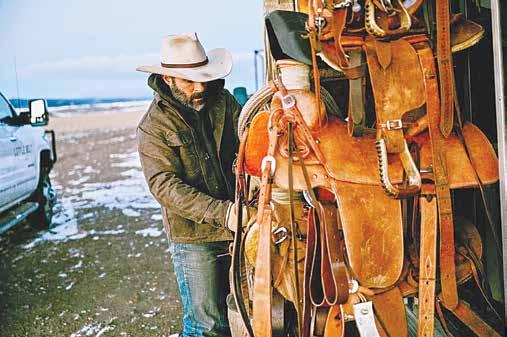

7L Diamond’s Hi Altitude Bulls
Leah and Peter Clark
Bulls sell March 22, 2024 at Valley Livestock in Monte Vista • 719-849-8223
Altenburg Super Baldy Ranch - Triangle J
Selling 120 bulls - Fort Collins, CO
Saturday, March 16, 2024
Willie Altenburg, 970-481-2570
Baty Livestock Spring and Fall Heifer Sales batylivestock@gmail.com Facebook/batylivestock
Black Summitt Cattle
The Quin LaFollette Family Bulls sell Friday, March 15, 2024 at Powell, WY • 307-899-3553
Bridle Bit Simmentals
All-Terrain Bull & Female Sale
Monday, March 18, 2024 at Walsh, CO Chad Cook, 719-529-0564
Campbell Simmental Part of High-Altitude Bull Sale
Saturday, March 23, 2024 at LaGarita, CO Robert, 970-749-9708

Dilka Cattle
Yearling and 18-mo-old bulls, PT Briggsdale, CO • 970-396-8791 thedilkas@aol.com
Far Out Cattle Ranch
Jerrid Brisendine, 719-353-1747
All-Terrain Bull & Female Sale Monday, March 18, 2024 at Walsh, CO
Hill Brothers Livestock Bulls and Females always available. Paul, 417-849-6851 Facebook.com/hillbrotherslivestock
Jay Hill Family
Simmental & SimAngus bulls Private treaty • 970-520-1555 jaywhill@kci.net
Mari Simmental Breeders
Ron Mari • Holyoke, CO Selling black % & PB ET bulls 970-520-7333 for EPDs & data
Phoenix Cattle Co.
Fleckvieh Simmentals & Fleckvieh/Angus seedstock Roger Schager • 303-550-5592
Cody Pitt
Black & Red bulls selling private treaty at Hotchkiss, CO 970-778-9267 • cmp5792@aol.com
Rains Simmental
Bulls of the Prairie sale
Saturday, March 9, 2024 at Oakley, KS Mike Rains, 785-672-7129
Russell’s Reflected R Ranch
Top bulls for sale private treaty Call Curt, 719-469-2857 for data or go to www.ReflectedRRanch.com
T-Heart Ranch
High-Altitude Bull Sale, March 23, 2024 719-850-3082 or 719-850-3083 shane@t-heartranch.com

For sale dates, show details and event highlights, go to: wwwColoradoSimmental.com, e-mail colosimmental@gmail.com or follow us on Facebook
SimGenetics
these Colorado breeders:
Get your
from
Always serving – Greg Putnam, a Navy Seal of 10 years, and his Veteran partners returned from serving the nation in the military to serving the local beef industry of Montana. Courtesy photo


Continued from previous page
regenerative way in terms of grazing. The goal is to raise high-quality beef with a focus on soil and pasture health.
“We are now seeing an increase in overall performance of our cattle and the
land we manage,” Putnam stated. “This involves our overall grazing plan and our cattle performance plan. They are very much tied together.”
Putnam noted any ranch that has stayed in business
very long is using some kind of sustainable practice.
“When we see the value of those practices, it’s undeniable – such as how our pastures look today and the way they are managed, compared to when we started,” he said. “We have increased our carrying capacity, as well as

overall quality and quantity of forage. This correlates to the overall performance of our cattle with higher conception rates, bigger and healthier calves in the fall, etc.”
This also translates to increased value through overall environmental impact.
“We believe our products are good for the people consuming them, good for the environment and good for telling the story about beef,” he stated.
Benefiting the










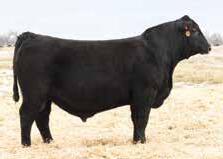






















beef industry
To conclude, Putnam noted one of the goals at Little Belt Cattle Company is to provide a positive benefit to the beef industry by sharing strategies that have worked for them with other producers.




ird Annual Embryo Sale MARCH 21
6:00 and online with www.northernlivestockvideo.com
FEATURING THE TOP PRODUCING VERMILION COWS AND SOME OF THE BEST SIRES IN THE ANGUS BREED.
New to the Embryo Sale 25 Fancy Registered Bred Heifers Right out of the heart of the fall program. Bred to SR ree Rivers 2087 and Vermilion G017 Bomber K022. Will calve in a 10 day period starting on September 25.







5,000 Fancy Open Commercial









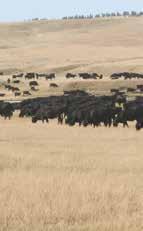






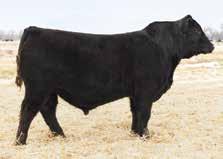

“If more ranches put more acres into this type of production system, the collective benefit will be significant,” he said. “I want people to know our cow performance has increased due to these grazing practices and our profitability has increased.”

















“A lot of multigenerational ranches are afraid to make changes because if they don’t work and there is a negative financial impact, it could be enough to end that multigenerational business,” he continued. “This is a lot of pressure to be cautious.”
Since most producers only want to make changes if they know the outcome will be positive, it makes trying new things scary and overwhelming.
“The ranch we bought and put together was in various states of deferred maintenance and mismanagement. In the short time we’ve been running it, the difference in what it looks like now, compared to when we bought it and what it probably looked like for the past 40 to 50 year is noticeable,” he shared. “People who have lived in this area much longer than us have seen the change. The benefits of good grazing practices are undeniable.”
Heather Smith Thomas is a corresponding writer for the Wyoming Livestock Roundup. Send comments on this article to roundup@ wylr.net.
B2 Wyoming Livestock Roundup • Volume 35 No. 45 • March 2, 2024 Pat Goggins Family Bob Cook - Records & Sales Cell: 406-670-0078 Je Mosher - Vermilion North Brandon Mosher - Pryor Creek Jake Kading - Herdsman Cell: 406-672-5844 Bill Shaules - South Pryor Will Ecord - Diamond Ring PO Box 30758 Billings, MT 59107 Email: bcook@cattleplus.com www.vermilionranch.com Vermilion Ranch Sale broadcast and videos available online through Northern Livestock Video Auction www.northernlivestockvideo.com 5,500 ANGUS SELL Vermilion Ranch Vermilion Ranch Follow Us 500 TOTAL PERFORMANCE YEARLING ANGUS BULLS Bulls sired by: Connealy King Air, Ellingson Badlands, Vermilion Leo, Vermilion Bomber G017, Vermilion In uence, S A V Glory Days, Ellingson ree Rivers 0065, Sitz Savvy. • Genomic tested with • Free delivery in Montana and adjoining states • First breeding season guarantee • Large sire groups with many half and three-quarter brothers • All fertility measured and soundness evaluated • Volume discounts FRIDAY, MARCH 22, 2024 Bulls sell at the Public Auction Yards, Billings, MT - 11:00 Spring Performance Sale THURSDAY, MARCH 21, 2024 Heifers sell at the South Pryor Development Center, Billings, MT - 12:00 200 embryos from Vermilion’s best sell at the Public Auction Yards, Billings, MT -
Replacement Angus Heifers All One Iron - Bang’s Vaccinated - Ready to Breed - Montana’s Best Vermilion Leo L045 Act BW Adj WW Adj YW BW WW YW MILK 78 773 1333 +0 +77 +128 +34 AAA 20651490 SIRE: Vermilion Leo MGS: HF Alcatraz 60F Vermilion Glory Days L162 Act BW Adj WW Adj YW BW WW YW MILK 90 800 1387 +3.4 +79 +134 +25 AAA 20651595 SIRE: S A V Glory Days 1832 MGS: Casino Bomber N33 Vermilion Lass 2814 AAA 20593920 SIRE: Ellingson Three Rivers 0065 MGS: Connealy Spur Bred to calve 9/29/2024 to Vermilion G017 Bomber K022. Vermilion Savvy L231 Act BW Adj WW Adj YW BW WW YW MILK 98 804 1431 +3.6 +82 +131 +22 AAA 20670238 SIRE: Sitz Savvy 732H MGS: Sitz Conformation 689A Vermilion G017 Bomber L154 Act BW Adj WW Adj YW BW WW YW MILK 96 858 1384 +1.6 +87 +149 +24 AAA 20651587 SIRE: Vermilion Bomber G017 MGS: Vermilion Re-Ride Vermilion Badlands L114 Act BW Adj WW Adj YW BW WW YW MILK 80 723 1243 +1.2 +72 +127 +26 AAA 20656816 SIRE: Ellingson Badlands 0285 MGS: Vermilion Charge On G162
Local beef – Greg Putnam and his partners started Little Belt Cattle Company to put local beef back into the supply chain for Montana communities. Courtesy photo Sustainable supply chain – Today, Little Belt Cattle Company is a vertically-integrated sustainable supply chain, where they oversee everything from calves hitting the ground to wholesale beef purchases. Courtesy photo
The number of dairy replacement heifers in the U.S. has plummeted nearly 15 percent during the past six years to reach a 20-year low, according to data from the U.S. Department of Agriculture’s (USDA) most recent cattle report.
What does this mean?
Any potential opportunities to boost dairy exports may be stymied by an inability to expand U.S. milk production, according to Corey Geiger, lead dairy economist for CoBank.
Beef on dairy
“This imbalance has prompted dairy farmers to reduce their heifer replacement inventories, in large part by breeding more dairy heifers and cows to beef bulls,” Geiger explains. “Contraction in the U.S. beef herd due to drought and other adverse conditions has led to record-high prices for beef cattle and retail beef products.”
Geiger says the rising cost of raising dairy heifers has far outpaced increases in heifer values over the past several years.
“Raising dairy heifers has been a losing proposition for most farmers in recent years, to the tune of $600 to $900 per animal,” Geiger says. “To better manage on-farm heifer inventories, dairy farmers have turned to using beef semen on a portion of their dairy herd to reduce the number of replacement heifers.”
“This has enabled farmers to cut the costs associated with raising heifers and generate additional income from beef sales,” he adds.
Less than a decade ago, dairy heifers sold for a tidy profit, but costs to raise them today means they sell at a loss.
While heifer-rearing cost estimates vary, they are all trending upward.
University of Wisconsin Extension survey data from 1999 to 2015 found the total cost to raise a dairy heifer from birth to entering the milking herd climbed from $1,360 to $2,510 per head.
In a similar analysis looking at 2016-21, Penn State Extension specialists calculated heifer-raising costs averaged $2,034.
Meanwhile, heifer values have not kept pace with higher rearing costs, Geiger notes.
“From April 2018 to January 2022, the sale price of dairy heifers never exceeded $1,400 per head, according to USDA’s Agricultural Prices report,” he says. “The discrepancy between rearing costs and sale value led to a prolonged and steady decline in replacement heifers in recent years.”
Some fluctuation in the population of replacement heifers is a natural outcome of market and economic forces, according to Geiger. But, a sufficient inventory is important to
the continuity of U.S. milk production and is critical to the industry’s ability to expand.
“While the number of replacement heifers has dropped to a 20-year low, the overall U.S. dairy herd has been stable, with 9.3 to 9.4 million head of dairy cows over the last six years,” he notes.
The steep drop in the heifer supply went largely unnoticed until recently, when dairy farmers went looking to buy nowscarce replacements. As a result, dairy replacement prices have now jumped to an eight-year high, with USDA data and auction market reports ranging from $1,890 to $2,800 per head.
Long-term situation
“These higher replacement values will likely be in place for the foreseeable future given the tight supply,” Geiger says.
The shrinking replacement pipeline will impact the ability to grow U.S. milk production for some time.
“Even if dairy producers reverse course and use more dairy bull semen in the coming years, it will be two to three years before the resulting dairy calves reach the milking barns,” he says.
Fran O’Leary is an editor for Wisconsin Agriculturist . This article was originally published in Wisconsin Agriculturist on Feb. 20.

Reported By: Curt Cox, WYLR Field Editor Feb. 25, 2024
Mount Rushmore Angus Ranch, Rapid City, S.D. Auctioneer: Kyle Shobe 116 Yearling Angus Bulls Avg. $6,149
Top Sellers
Lot 51 – D U Virtue
312 – Price: $13,500 DOB: 1/16/23 Sire: Sitz Virtue 11710 Dam’s Sire: Haynes Outright 452 EPDs: BW: +0.8, WW: +78, YW: +141 and Milk: +28 Buyer: Darby and Autumn Jespersen, Hemingford, Neb.
Lot 109 – M R A Testa-
ment 3026 – Price: $13,500
DOB: 1/6/23 Sire: Tehama
Testament Dam’s Sire: Connealy Emerald EPDs:
BW: -0.1, WW: +71, YW: +123 and Milk: +19 Buyer: Poss Angus, Scotia, Neb.
Lot 7 – M R A Fair
N Square 3073 – Price: $13,000 DOB: 1/12/23
Sire: Myers Fair-N-Square
M39 Dam’s Sire: Sitz Alpine 11076 EPDs: BW:
+3.7, WW: +89, YW: +151 and Milk: +24 Buyer: 63 Land and Cattle, Rapid City, S.D.
Lot 38 – M R A Virtue 3088 – Price: $11,500
DOB: 1/13/23 Sire: Sitz
Virtue 11710 Dam’s Sire:
KG Justified 3023 EPDs:
BW: -0.6, WW: +77, YW: +129 and Milk: +31 Buyer: Green Mountain Angus, Ryegate, Mont.
Lot 3 – M R A Fair
N Square 3049 – Price: $11,000 DOB: 1/9/23 Sire: Myers Fair-N-Square M39 Dam’s Sire: Poss Achievement EPDs: BW: +3, WW: +98, YW: +173 and Milk: +32 Buyer: Darby and Autumn Jespersen, Hemingford, Neb.



New All Metal Stirrup Buckles
Blevins new all-metal stirrup buckle in 3”& 2-1/2” widths. The 3” and 2-12” widths have the posts set horizontally and fit standard holes while the 2” width has the posts set vertically. Made of stainless steel and heat-treated aluminum, the same as our leather-covered buckles.

Blevins Stirrup Buckles Improved
Sleeves same as on regular style buckle. The tongue has no hinge or strap. Available in 3” and 2-1/2” widths.


Easy to change stirrup lengths quickly and easy to install – won’t slip or stick. Made of stainless steel and heat-treated aluminum. Sleeves covered with leather. Order either improved, regular or four post buckles. Also new all-metal buckle in 3”, 2-1/2” and 2” widths. At your dealers or:
B3 Wyoming Livestock Roundup • Volume 35 No. 45 • March 2, 2024
dairy heifer numbers may
milk
BLEVINS MANUFACTURING COMPANY INC. WHEATLAND, WY 82201
Declining
impact
production BLEVINS
Mount Rushmore Angus Ranch Annual Bull Sale
SALE REPORTS Subscribe to the Wyoming Livestock Roundup for $60 per year by calling 307-234-2700
SALE REPORTS
JC Heiken Angus and Sons Annual Production Sale
Reported By: Curt Cox, WYLR Field Editor Feb. 27, 2024
Miles City Livestock Commission, Miles City, Mont.
Auctioneer: Joe Goggins
145 Yearling Angus Bulls Avg. $6,029
– Price: $13,000
DOB: 2/17/23 Sire: Sitz
Incentive 704H Dam’s Sire: LT Regions 4110 EPDs:
BW: +4.3, WW: +81, YW: +146 and Milk: +29 Buyer: Stovall Ranches, Billings, Mont.
Lot 3 – Heiken Incen-
tive 3070 – Price: $10,000
DOB: 2/8/23 Sire: Sitz
Incentive 704H Dam’s Sire:
Connealy Judgement EPDs:
BW: -0.6, WW: +77, YW: +130 and Milk: +30 Buyer: Stovall Ranches, Billings, Mont.
Lot 35 – Heiken Stunner 3211 – Price: $10,000 DOB: 2/25/23 Sire: Musgrave
1676 Stunner 1905 Dam’s Sire: Jindra Acclaim EPDs:
BW: -0.4, WW: +75, YW: +128 and Milk: +39 Buyer: Minow Ranch, Olive, Mont.
Lot 31 – Heiken Cowboy Kind 3106 – Price:
$9,750 DOB: 2/9/23 Sire: HA Cowboy Kind 8157
Dam’s Sire: Stevenson
Solution 3191 EPDs: BW: +1.1, WW: +74, YW: +131 and Milk: +37 Buyer: Fredricks Ranch, Decker, Mont.



Kretschman Angus
Annual Bull Sale
Reported By: Curt Cox, WYLR Field Editor Feb. 24, 2024
Buffalo Livestock Marketing, Buffalo Auctioneer: Kyle Shobe
65 Yearling Angus Bulls Avg. $7,088
Top Sellers
Lot 1 – KA Resilient
377 – Price: $11,500 DOB: 2/10/23 Sire: Sitz Resilient
10208 Dam’s Sire: B/D
Rice Stunner 9064 EPDs:
BW: +1, WW: +74, YW: +118 and Milk: +27 Buyer: Tom and Linda Lulias, Buffalo
Lot 5 – KA Coalition
371 – Price: $10,000 DOB: 2/11/23 Sire: U-2 Coali-
tion 206C Dam’s Sire: Sitz Resilient 10208 EPDs:
BW: -0.3, WW: +67, YW: +122 and Milk: +28 Buyer: Joe Bertalotto, McIntosh, S.D.
Lot 9 – KA Resilient
382 – Price: $9,750 DOB: 3/14/23 Sire: Sitz Resilient
Reyes/Russell Annual Bull Sale
Reported By: Curt Cox, WYLR Field Editor Feb. 26, 2024
MR Angus Ranch, Wheatland
Auctioneers: Lex Madden and Lander Nicodemus 226 Two-Year-Old Angus Bulls Avg. $7,961
Top Sellers
Lot 5 – MR General
35172 – Price: $36,000
DOB: 6/13/22 Sire: MR
General 2566 Dam’s Sire:
MR Deuce 22744 EPDs:
BW: +1.3, WW: +74, YW:
+122 and Milk: +31
Lot 1 – MR Outside 33272 – Price: $25,000
DOB: 5/29/22 Sire: KR
Outside 7687 Dam’s Sire:
MR Upright 4223 EPDs:
BW: +5.3, WW: +64, YW:
+121 and Milk: +29
Lot 2 – MR Cowboy
36742 – Price: $20,000
DOB: 6/19/22 Sire: Kesslers
Cowboy Up 8029 Dam’s
Sire: MR General 2566
EPDs: BW: +2.8, WW: +78, YW: +132 and Milk: +27
Lot 8 – MR Cowboy 37082 – Price: $20,000
DOB: 5/27/22 Sire: Kesslers
Cowboy Up 8029 Dam’s
Sire: MR Coach 20003
EPDs: BW: -0.2, WW: +62,
10208 Dam’s Sire: Barstow Cash EPDs: BW: +0.3, WW: +63, YW: +111 and Milk: +24 Buyer: Mill Iron Diamond Ranch, Shawnee
Lot 7 – KA Resilient
3001 – Price: $9,000 DOB: 2/8/23 Sire: Sitz Resilient
10208 Dam’s Sire: S A V Supercharger 6813 EPDs:
BW: +2.1, WW: +66, YW: +115 and Milk: +30 Buyer: Darrell Roush, Recluse
Lot 10 – KA Dry Valley
3024 – Price: $9,000 DOB: 3/9/23 Sire: Connealy Dry Valley Dam’s Sire: B Bar Righteous 76 EPDs: BW: -0.3, WW: +53, YW: +97 and Milk: +24 Buyer: Darrell Roush, Recluse
YW: +106 and Milk: +24
Lot 22 – MR Cowboy 36762 – Price: $19,500
DOB: 5/30/22 Sire: Kesslers Cowboy Up 8029
Dam’s Sire: Wiwa Creek
Density 20’15 EPDs: BW: +4.3, WW: +72, YW: +127 and Milk: +25
Lot 33 – MR General 35042 – Price: $16,000
DOB: 6/19/22 Sire: MR
General 2566 Dam’s Sire: KMR Wisdom 854 EPDs: BW: +2.7, WW: +66, YW: +109 and Milk: +26
Lot 80 – MR Command 34122 – Price: $16,000
DOB: 5/27/22 Sire: MR
Command 25269 Dam’s
Sire: Ideal 4223 OF 1168
BLKBRD EPDs: BW: +0.8, WW: +65, YW: +118 and Milk: +25

























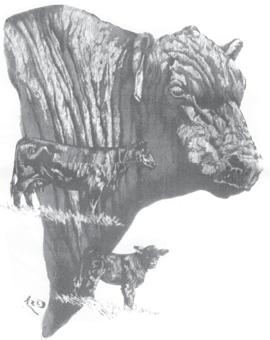






Wyoming Livestock Roundup • Volume 35 No. 45 • March 2, 2024 B4 LEGENDARY SINCE 1971 ROZOL PRAIRIE DOG BAIT Build your legacy with the legendary Rozol® Prairie Dog Bait. Brought to you by Liphatech Ag, your Most Valuable Partner for effective rodent control. Rozol Prairie Dog Bait is a restricted use pesticide. WE HAVE YOUR BACKS, BARNS AND BOTTOM LINES. Bulls are PAP, BVD and Semen Tested Northwest Wyoming Angus Association For information regarding the sale or for a sale catalog contact: Fred & Kay Thomas - (307) 868-2595 Thank You to our buyers from previous sales! 46th Annual Sale Tuesday, March 26, 2024 1:00 p.m. MST Riverton Livestock Auction Davidson Angus Hoggs Angus Obsidian Angus WYO Angus Sale viewing and Bidding available online at Pre-registration required to bid. Sale day phone beside phones listed is 307-856-2209. Consignors Top Sellers Lot 9 – Heiken Broadview 3068 – Price: $13,500 DOB: 2/8/23 Sire: Heiken Broadview Dam’s Sire: JCH In Focus 4175 EPDs: BW: +0.9, WW: +79, YW: +137 and Milk: +25 Buyer: Troy Sailer, Golden Valley, N.D. Lot 7 – Heiken Incentive 3172
Wyoming State Forestry provides update to the Joint Agriculture Committee
Cheyenne – In their annual Forest Health briefing, Wyoming State Forester Kelly Norris brought an update about Wyoming’s forests to the Wyoming Legislature.
“I come from a county which is 80 percent federal land, and much of it is forested land and Bureau of Land Management (BLM) sagebrush land,” says Speaker of the House Albert Sommers of Pinedale. “The policies happening on these lands happen to all of us – from grazers and oil and gas to recreators and wildlife enthusiasts.”
Forest health
“Forest health monitoring is a collaborative effort,” says Norris. “Over 19.3 million acres were surveyed for forest health threats in 2023. Out of the 19.3 million acres flown, approximately 88,000 acres were found to have insect, disease or abiotic issues, excluding fire, which is down from aerial surveys conducted in 2022.”
With above-average rainfall in 2023, after three consecutive years of prolonged drought, she notes there was likely a decrease in Wyoming’s most damaging insect.
“The western spruce budworm continues to be Wyoming’s most damaging force by acreage,” she continues. “This is a defoliator which typically attacks Douglas fir trees.”
Mountain pine beetle killed trees and continues to increase across the state.
In Pinedale, a rare outbreak of white satin moth caused problems in narrowleaf cottonwood, aspen and willow trees in and around the city.
In other invasive species news, monitoring continues for the emerald ash borer, and the species has not yet been seen in Wyoming.
The Japanese beetle was found in Sheridan in 2020, but no further identification of the insect has been seen.
One positive confirmation of the spongy moth was found in Park County, as well.
“Due to the concern of transferring non-native insects to the Black Hills via green logs, Wyoming State Forestry, the U.S. Forest Service (USFS) and Neiman Timber Company coordinated a surveillance program,” Norris says.
In the process of debarking all of the logs, no insects of concern were identified in the traps.
Fire season
2023 was the second year in a row of a below-average fire season, with only 515 fires on 10,789 acres.
“State forestry processed 675 fire bills, which included about 800 firefighters,” Nor-
ris notes. “Our Wyoming team assisted in fires in Louisiana, Idaho, Montana and Utah.”
Additionally, Wyoming State Forestry celebrated its 20th year in the Helitack program. Over the last 20 years, the Helitack program responded to 686 incidents and had 76 state forestry seasonal workers participate.
The Single Engine Air Tanker (SEAT) program also assisted in the state throughout the year. Norris noted the program is a “true collaborative effort” with multiple partners making investments at the SEAT base at the Casper Airport.
Good Neighbor Authority
Wyoming State Forestry is also working to increase the pace and scale of active management on Wyoming’s federally-managed forests through the Good Neighbor Authority.
“The Good Neighbor Authority program allows the state to partner with federal agencies to do work on federal lands by utilizing the state’s expertise and contracting system to help get more work done on the ground,” Norris explains.
Since the program started, state forestry has contracted over 11,000 acres of federal lands, selling 32 million board feet of timber. In 2023, the Roughneck Timber Sale on the Uinta-Wasatch-Cache National Forest will provide logging on 1,402 acres.
Norris also says the program will continue to grow, with plans to conduct National Environmental Policy Act surveys and forestwide agreements with the Shoshone and Caribou-Targhee National Forests.
Large-scale projects, including collaboratives with non-governmental organizations, are occurring throughout Wyoming.
“Beyond the use of the Good Neighbor Authority program, state forestry has reinvigorated the shared stewardship conversation with the USFS Intermountain and Rocky Mountain regions,” Norris explains. “Shared stewardship is about acknowledging Wyoming’s priorities and incorporating them into the USFS planning efforts, with an end goal for both regions to allow their action to a place we all agreed need the most work done, no matter the ownership.”
Forest plans
With forest plans coming forward, Norris notes each region is kicking off at least one major forest plan revision, and state forestry plans to be actively engaged in those efforts.
“There are several forest plans about to be developed,
“There are several forest plans about to be developed, and what comes out of those will be critical to the state of Wyoming and people like me, frankly, in my area. I think how we as citizens, industries and legislators can become involved in these processes meaningfully is important.” – Albert Sommers, Wyoming Speaker of the House
and what comes out of those will be critical to the state of Wyoming and people like me, frankly, in my area,” says Sommers. “I think how we as
citizens, industries and legislators can become involved in these processes meaningfully is important.”
Watch the entirety of


the Forest Health Briefing on YouTube at youtube.com/live/VTkWX4TlSo?si=ANfw6XIaML3 bpNxy
WBC teamed up with the Wyoming Hunger Initiative, 307 Meat Co. and the Wyoming Stock Growers Association to provide beef sticks to children with food insecurity.
The Beef for Backpacks program is now in 20 Wyoming counties and is projected to provide over 200,000 beef sticks this school year.


If you are interested in donating beef, please contact Olivia Sanchez at the Wyoming Stock Growers Association, (307) 638-3942 or Trista Ostrom at the Wyoming Hunger Initiative, (307) 777-7398.
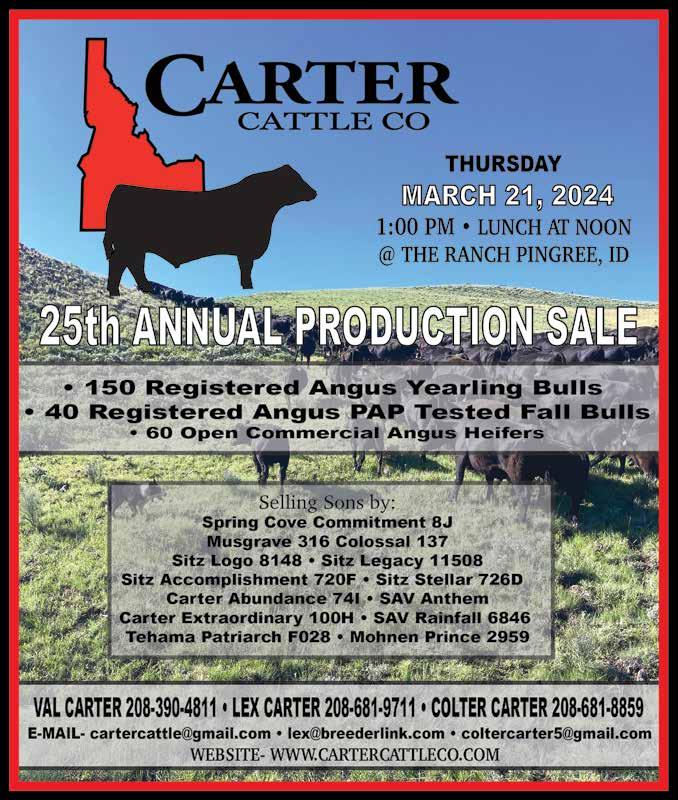
B5 Wyoming Livestock Roundup • Volume 35 No. 45 • March 2, 2024
Saige Zespy is a corresponding writer for the Wyoming Livestock Roundup. Send comments on this article to roundup@wylr.net.
AG of Heart
BY AMANDA RADKE

In Times of Stress, Who do You Turn to?
There’s no doubt about it, farmers and ranchers live under a great deal of stress. This way of life requires hard work, resilience, constant effort and an ability to pivot and navigate through many factors completely outside of a person’s control such as market volatility and weather.
Add in constant attacks on our ability to own and manage our land and livestock as we see fit, and it’s a heavy burden for producers to carry.
There is no shortage of things coming our way –
proposals to measure our emissions in the Godless government grift of carbon capture and climate change intervention; the relentless propaganda coming from animal rights activists; the fact our elected officials, who vote on our behalf, are unfamiliar with where their food comes from and how it is grown; the skewed messaging being presented in schools teaching our kids farming is bad and the list goes on.
In my travels, I talk to countless agricultural families, and they are all feeling
this pressure on and off of the farm.
I recently spoke at a women in agriculture event in Indiana, and one of the workshops was on reducing farm stress.
As so many do, I carry a heavy weight on my shoulders, and I thought, “Why not? Let’s see what the session has to offer.”
Now, I’m sure the workshop was meaningful to some. There was advice on sleep, diet, exercise and creating a home environment that is peaceful and calm. There was talk of soothing paint colors and plants in offices, using stress balls and practicing mindful meditation.
As I sat there listening though, a few thoughts came to mind.
The first was, “Is stress really bad? Is it something we should strive to eliminate?”
Calving season is stressful. Planting and harvest
season is stressful. Building a business is stressful. Raising children can be stressful at times. Taking on extra community service projects or leadership roles can be stressful. Testifying at the Capitol or fighting for meaningful change in the political arena is certainly stressful.
The reality is the demands of life are stressful. But what I have realized is anything in life worth doing is hard. I don’t want the easy road. I just want the ability to take on the task joyfully and to find strength to continue to push forward even in the difficult moments.
It’s not stress that kills us, it’s our reaction to it. It can either act as an accelerator, a motivator and a driving force to take on things much bigger than ourselves. Or, it can cripple us with fear, anxiety and worry.
So how do you choose
one or the other? My Christian faith would dictate to me instead of stress balls, fruit smoothies and breathing techniques, I only need to turn to the Bible to give me the answer.
John 16:33 reads, “I have told you these things, so that in me you may have peace. In this world you will have trouble. But take heart! I have overcome the world.”
Isaiah 41:10 reads, “Fear not, for I am with you. Be not dismayed, for I am your God. I will strengthen you. Yes, I will help you. I will uphold you with My righteous right hand.”
There’s no promise this life will not be hard. It will, and it is. And I suppose it’s due to living in a secular world where it’s not politically correct to talk about our faith that these fundamental truths are left out of the conversation.
If life is heavy for you
right now; if you’re feeling lost, aimless or hopeless; if you’re worried about the future; if you’re facing the unimaginable, toss the spinach and turn to Jesus. He is always with you, just waiting for you to lean on Him.
And once you walk with Jesus, you’ll soon find strength, courage, fortitude, joy and peace, even in the hardest of times.
With this, I hope this column brings you comfort and a reassurance we can do hard things, we can face great evils and fighting for our children and grandchildren is worth it.
This is my prayer for each and every one of you.
But we can’t do it alone through our own grit and “buck up” attitude. However, we can do anything with Him.
Amanda Radke is a rancher, author, motivational speaker and podcast host. For more from Radke, visit amandaradke.com










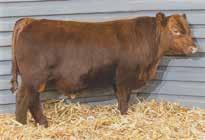


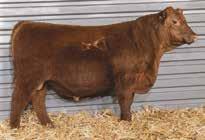


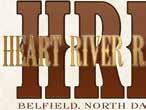




Despite mild winter, spring may bring forage challenges
This year’s warmer and drier winter conditions have created certain benefits for ranchers, such as easier winter feeding and simpler maintenance of water supplies. A major benefit of milder conditions is cold weather stressors on the cow herd are lower, making it easier to meet cattle nutrient requirements.
As helpful as this mild weather has been, there are potential concerns ranchers should be aware of and be prepared for this spring, according to James Rogers, North Dakota State University (NDSU) Extension forage crops production specialist.
“The Northern Plains is a fragile environment, subject to extreme heat, cold and limited rainfall,” Rogers says. “When these extremes occur, it can create instability in the system with long recovery periods. Looking at the forecast weather model from the National Weather Service Climate Prediction Center, the El Niño effect of warmer, drier weather is predicted to continue to the spring.”
Implications for farmers
Forecast models are predicting continued above-normal temperatures with equal chances of above- or belownormal precipitation.
If the weather forecast models hold true, the implications for spring can mean one thing for the crop farmer and another for the rancher.
For the crop farmer, above-normal temperatures could mean earlier planting conditions compared to previous years. Potential downsides include early weed emergence and the uncertainty of receiving the precipitation necessary to get crops up and going.
Implications for ranchers
For the rancher, a few more variables can cloud the picture.
The first is how pasture and range plants were managed prior to the end of the grazing season. Fall is a time
when pasture and range plants are storing energy for spring growth. The basis for forage production is tiller production and growth. If tiller production is reduced, forage production will be lowered.
An NDSU study evaluated the effect of the intensity of fall grazing on forage production the following year. They found severe fall use reduced forage production by 57 percent in 2022 and 54 percent in 2023.
“Severe fall use of pasture and range plants has a negative effect on energy storage, bud formation and tiller production, which results in reduced forage production the following year,” Rogers says.
The second variable is unknown – what will spring conditions truly be?
If temperatures continue to remain above normal, pasture and range plants will begin coming out of dormancy early. If precipitation remains below normal, biomass production could be delayed, meaning spring turnout could also be delayed.
On the other hand, spring could arrive late with late winter storms wreaking havoc on ranchers and livestock, as in the springs of 2021-22.
Rogers advises ranchers to be prepared for either situation and consider whether winter feed supplies are enough to stretch into spring.
The third variable is cow herd health and condition from now through spring.
Calving season is underway and monitoring calf health, cow condition, herd bull health and management are all critical from now until the end of breeding season. Management now affects rebreeding later.
Elizabeth Cronin is an information specialist and interim director of agricultural communications for NDSU Extension. This article was originally published by NDSU Extension on Feb. 16.
Wyoming Livestock Roundup • Volume 35 No. 45 • March 2, 2024 B6 C mi ed to efficiency & l gevity in any env ment! Chuck & Annette Steffan 4291 Hwy 85 South Belfield, ND 58622 701-575-8145 Cell: 701-290-9745 • 701-260-4630 heartrivergenetics@yahoo.com heartrivergenetics.com Wednesday, March 13, 2024 The Feedlot • Belfield, ND Lunch 11:30 a.m. MT Sale 1 p.m. MT Annual Producti Sale Buy with c fidence – Our bulls are genomic tested, parent verified, carcass ultrasounded and fertility tested. 60 Red Angus Yearling Bulls 30 Red Angus Yearling Heifers 10 Red Angus Comm. Bred Heifers from guest consignor Including a good selection of heifer-bull prospects. Registered & Commercial Red Angus Heifers Available by Private Treaty Selling: O dedicati to producing quality p f mance ca le is a c tinuing c mitment to r cust s. We practice selection and culling for traits that support efficiency and longevity within our environmental constraints of the Badlands in North Dakota. Cattle that excel in this setting can flourish just about anywhere else! S iving f mod ate, easy-fleshing ca le. LOT 1 –
HRR NAVIGATOR 3245 #4805890
LOT 2 – HRR EXPRESS 3201 #4806054
LOT 3 – HRR JOURNEYMAN 3248 #4805612
5 –
LOT
HRR DATA 3242 #4805676
6 –
LOT
HRR TENOR 3285 #4805966
LOT 4 – HRR TENOR 3232 #4805830
Growing cotton in the desert is challenging. But, intense summer heat, occasional insect infestations and urban encroachment are nothing new for Jerry Rovey, who has farmed west of Phoenix for over 60 years.
Rovey continues farming cotton in a region that, perhaps sooner than later, will close a chapter on farming in Arizona as cities like Buckeye, Tolleson and Goodyear continue to merge in a seamless urban landscape surrounding Phoenix.
Once just a small farming community some 30 miles west of downtown Phoenix, Rovey has seen his region grow rapidly. In 2017-18 and again in 2021, Buckeye, Ariz. was America’s fastest-growing city.
This year, Farm Press honored Rovey for his commitment to Arizona cotton and his longstanding acumen of sustainable farming practices with its annual High Cotton Award.
Rovey is a lifelong cotton industry leader in Arizona, where most recently he served as board chairman for the Arizona Cotton Growers Association.
Rovey owns Flying R Farms in Buckeye, Ariz. with his wife Dianna and their sons Dean and Todd.
Arizona cotton
Rovey grows Upland varieties along the Gila River, alongside alfalfa, wheat and silage corn.
Since 2008, Rovey has partnered with Deltapine cotton and its New Product Evaluator (NPE) program to test new varieties under desert conditions. The program is a collaboration between Deltapine and cotton growers across the U.S. Cotton Belt.
About 10 years ago, Rovey pushed one of those full-season DP varieties with some extra water to yield over seven bales per acre in one plot.
Insect control
The advent of Bt cotton and technologies like ThryvOn have helped cotton farmers control insects.
Coupled with useful advice from Land Grant entomologists, including Peter Ellsworth from the University of Arizona, Rovey can control whitefly and lygus much easier because of an understanding of how beneficial insects work. But this wasn’t always the case.
“Before Bt cotton, we were spraying every four or five days for pink bollworm,” Rovey said. “Sometimes we’d have to spray every three days. We were killing everything, including the beneficial insects.”
Concerted efforts across the Cotton Belt eradicated the pink bollworm, but other insects like lygus and white flies can still be troublesome.
Rovey says the new ThryvOn technology by Bayer Crop Science helps too. The Bollgard Three
ThryvOn cotton with XtendFlex technology is touted as the cotton industry’s first biotech trait to give builtin protection against various insect species.
Between this and the beneficial insects common to his area, Rovey has greatly reduced his need for insecticide treatments.
Last season was a pleasantly easy year for lygus control in his area, he said. Various reports suggest lygus pressure was light across Arizona.
When he does treat his cotton, the proximity of homes and schools in the region has forced Rovey to use ground rigs and work around school hours.
“We try to use a minimum amount of chemicals because they’re expensive,” he said. “We’re also faced with air quality and dust control issues, so we have to be careful.”
Rovey said timing his insecticide treatments at nights and weekends near schools is one part of his management strategy.
Crops
Cotton is just one of the crops Rovey grows. His cotton is planted on 38-inch rows. Land and water availability continue to limit his cotton acreage.
Flying R also does custom harvesting in the region for other cotton farmers.
“We pick for everybody around here,” he said. “I think last year we did over 2,000 acres, which is the only way we can afford these machines.”
Cotton is typically planted by May, with harvest activities continuing into December. Rovey may strip till cotton behind alfalfa or a wheat crop. An average season for Rovey will see three to four bale yields of Upland cotton.
Despite Upland prices languishing under a dollar per pound, Rovey has managed to take advantage of high whole cottonseed prices to the dairies.
“On a three-bale crop this is a good amount of money,” he said of whole cottonseed.
Rovey likes to look at the larger picture of cotton returns. To him, it’s not merely about the price paid for his baled cotton, but also the whole cottonseed and crop insurance.
“So, when you factor all of those in, and you get a little bit of payments on the price and the insurance programs, it helps,” he continued. “I see a lot of people get out of cotton and go all in on alfalfa, and that’s the only thing they have.”
Alfalfa has been a lucrative crop for Rovey as well, particularly in the winter months when winter travelers, commonly referred to as “snowbirds,” travel south and bring their horses with them to south-central Arizona.
“Right now, the snowbirds are starting to show up,” he told Farm Press. “A lot of people coming out of
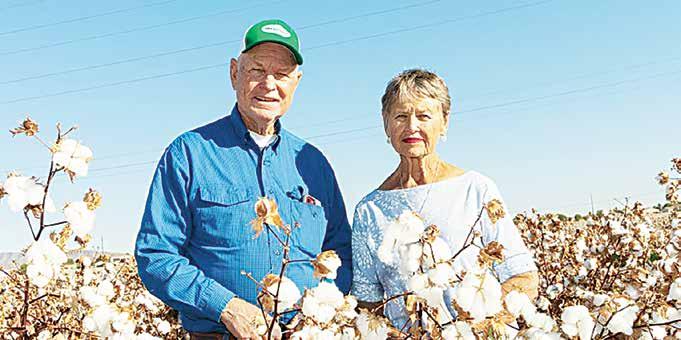
Wyoming or other parts of the U.S. bring their horses down. We’ve already started shipping hay to them.”
Water Water in the West is critical to irrigated agricul-
ture. It’s a necessity that isn’t taken lightly.
Rovey’s irrigation water comes from districts which pump from underground. The surface water supplies coming into the area through the Central
Arizona Project now goes entirely to cities as drought regulations eliminated those deliveries to farms in the state.
Flood and furrow irrigation is all he can do because of the slope of his
land. Water quality issues prevent the use of subsurface drip.
Todd Fitchette is an associate editor for Western Farm Press. This article was originally published in Farm Progress on Feb. 16.

B7 Wyoming Livestock Roundup • Volume 35 No. 45 • March 2, 2024
High Cotton Award winner – Jerry and Dianna Rovey farm cotton near Buckeye, Ariz. Todd Fitchette photo
Jerry Rovey is 2024 Western High Cotton Award winner
Overgrown beef cattle hooves can lead to lameness, extreme discomfort, infections and other serious issues.
Identifying the root cause of a hoof problem early on can help producers address the issue swiftly to prevent long-term damage and agitation.
On occasion, providers may need to trim beef cattle hooves to help keep them from going lame, according to Kansas State University (KSU) Beef Cattle Institute (BCI) veterinarians.
During an episode of BCI’s Cattle Chat podcast, dated Feb. 16, KSU veterinarians suggest some beef

cattle may require occasional hoof trimming and address the necessity of regular hoof trims for herd animals.
Factors affecting hoof health
“In beef cattle operations, cows walking around on the ground, rocks and sand typically have nor-



mal wear which keeps their hooves the length they need to be,” states KSU Veterinarian Dr. Brian Lubbers. “However, sometimes older cows that don’t move around much will need to have their hooves trimmed.”
Lubbers adds if every few cows out of 100 need hoof trims, it is considered to normal.
“If two percent of the herd needs a routine trim, it’s to be expected. But, if 50 percent of the herd needs to have their hooves trimmed yearly, then there is likely something else going on,” Lubbers notes.
KSU Veterinarian Dr. Bob Larson suggests excess hoof growth could be linked to diet, especially a highgrain diet causing acidosis, which can lead to hoof problems.
“Cattle eating a highgrain diet or ones consuming crop residues with substantial amounts of grain can get acidosis, which can lead to hoof problems,” Larson says. “Also, there are some minerals that need to be included in the diet to promote healthy hoof growth.”
Genetics can also influ-
ence hoof growth, notes
KSU Veterinarian Dr. Brad White, citing corkscrew claw as an example.
This condition causes an animal’s toe to turn in such a way that the outer hoof wall can come in direct contact with the ground because the toes turn inward, making the toe looks like a corkscrew, hence, the name corkscrew claw.
“There is a genetic component to corkscrew claw, which is a claw that turns under the hoof, and those will have to be trimmed regularly,” White states.
Hoof management
On a previous BCI Cattle Chat episode from December 2020, Larson discusses cattle environment, which can also lead to hoof issues. For example, if cattle are standing in mud, they can experience foot rot.
“Foot rot is a bacterial infection which occurs between the claws of the hoof. In the summer, it can develop when cattle are standing in wet or muddy areas,” Larson says.
He adds foot rot typically occurs when cows get a cut from a rock on the soft tissue between the hoof claws and an infection develops in the wound.
cally responds well to antibiotic treatment and the animal will be back to being sound pretty quickly after appropriate treatment.
One of the easiest ways to prevent foot rot is to manage cattle in a clean, dry environment to minimize mud exposure, Larson explains. He further notes some producers include iodine in their mineral mix or as a feed supplement.
“With any iodine or salt feed additive it is hard to know for sure the cow is getting the right dose, so it might offer some preventative aspects, but it would not be a treatment,” Larson notes.
Also, if cows happen to step on a sharp object, they can develop an abscess in the soft tissue attached to the hoof.
“Any time cattle experience a hoof issue, it is really important to get them in so a veterinarian can do a thorough examination to determine the problem and treat it appropriately,” Larson concludes. “Early identification of the problem and quick treatment is key, as well as preventative management.”
Celebrating our 60th year in the Angus seedstock business. We truly appreciate all the support over the years and will continue to be a trusted seedstock source for many years to come. Our PATH has not wavered. Our FOCUS has and will continue to be to produce profitable, problem-free cattle for the commercial cow/calf producer. We BELIEVE an efficient, highly maternal, lowmaintenance cow herd is key to a profitable operation.
PRODUCTION SALE March 27th at 3:00 PM at the Ranch.
SELLING 130 Bulls, 30 Registered Yearling Heifers, 25 Mc Cumber Commercial Open Heifers and NEW this year Mc Cumber influenced Bred and Open Commercial Heifers.
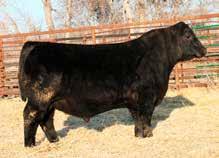
MC CUMBER ARCHIVE 3187
REG#- 20840687
Combining the maternal strength of the Miss Wix cow family with OCC Edge of Glory 841E, Archive represents a new generation herd sire from his Pathfinder,
MC CUMBER 073 ZODIAC 3119
REG #- 20840656
A calving ease, herd bull prospect with the moderation, natural thickness, and capacity to sire progeny with the ability to adapt to any environment.
A maternal brother to last year’s Lot 2 and sale feature Mc Cumber La Joya 280 and grand son of the Pathfinder, donor dam Miss Wix 2012 of Mc Cumber
MC CUMBER LA JOYA 352
REG #- 20840752
The clear-cut top performer of the calf crop. He weaned off his dam at 945 lbs without creep and came off test weighing over 1400 lbs. He combines this with the capacity, natural thickness, softness and soundness of a cow-maker.


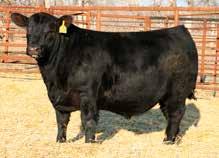
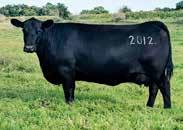

S“The organism causing foot rot lives in the soil so it is present all the time,” Larson states. “One of the first signs of foot rot is the impacted animal begins to walk with a limp or become lame.”
However, foot rot typi-
In the event of a hoof issue, the KSU veterinarians stress the importance of consulting a veterinarian for a thorough examination and appropriate treatment.
Melissa Anderson is the editor of the Wyoming Livestock Roundup. Send comments on this article to roundup@wylr.net.


Wyoming Livestock Roundup • Volume 35 No. 45 • March 2, 2024 B8
MISS WIX 2012 OF MC CUMBER REG# 17338588
MISS WIX 2003 OF MC CUMBER REG# 17338581
ons and grandsons of these cornerstone Pathfinder®
will headline
Donors
our 2024 Production sale.
MC CUMBER ANGUS RANCH
celebrating
www.mccumberangus.com Chuck: 701-246-3366 or 701-871-9800 Matt: 701-871-1072 e: mctastad@utma.com 8673 37th Ave, Rolette, ND 58366 SIRES REPRESENTED- Mc Cumber La Joya 098, Mc Cumber Tribute 702, Mc Cumber Zodiac 073, Mc Cumber Believe 1169, Mc Cumber Armour 7148, OCC Edge of Glory 841E, Duff 4 Real 16250 and Duff Red Meat 20114.
donor dam Miss Wix 2003 of Mc Cumber. Archive is a maternal brother to Steadfast, Armour and 9119. MC CUMBER MASTERPLAN 3194 REG#- 20840691 Power and performance enhanced by the maternal excellence of his Pathfinder, donor dam Miss Wix 2012 of Mc Cumber. Masterplan has been a standout from birth and never looked back. He combines the best of the Miss Wix and Lassie cow families. MILLS, WY 4515 W Yellowstone Hwy (Hwy 26) 307-439-2120 Stop in or contact us for a FREE consultation. Starting Our 47th Year Providing the Best Value in Post Frame Buildings Strongest Structure in the Industry We Manufacture & Construct Our Product Lifetime Steel Warranty Builders Risk & Full Insurance Why Choose CLEARY? 800-373-5550 ClearyBuilding.com MARCH 14-15 • 8 a.m. to 6 p.m. MARCH 16 • 8 a.m. to 3 p.m. CUSTOMER APPRECIATION DAYS SALE! JOIN US FOR OUR... Best Prices of the Season! Producers encouraged to look for several factors influencing cattle hoof health Midland bull test edition ® 307-234-2700 • wylr.net To advertise in the Midland Bull Test Edition, contact Calli at 605-695-1990 or calli@wylr.net Advertising Deadline: March 8, 2024 Insert Date: March 23, 2024 Adobe Stock photo
A love for space exploration led Jessica Atkin, a Texas A&M College of Agriculture and Life Sciences graduate student in the Department of Soil and Crop Sciences, to produce the first-ever moondustgrown chickpeas.
Using simulated moondust, because there’s not enough lunar regolith on Earth for experimentation, Atkin and her colleagues grew chickpeas to seed in mixtures of up to 75 percent moondust – a groundbreaking endeavor in several aspects.
As a result of her study, future moon-bound astronauts may have the opportunity to substitute a portion of their prepackaged foods with protein derived from crops grown on the lunar surface.
“The moon doesn’t have soil like Earth does,” Atkin said. “On Earth, the soil has organic material filled with nutrients and microorganisms, which support plant growth. Those are missing on the moon. This adds to other challenges, such as reduced gravity, radiation and toxic elements.”
To help address some of those challenges, Atkin has been developing a soil amendment to improve the structure and nutrient composition of lunar dust, making it suitable for growing crops.
Atkin collaborated on the project with Sara Oliveira Santos, a doctoral candidate at Brown University, who contributed expertise in addressing hydrological issues arising from the small particle size of moondust.
Moondust research
Atkin has been working on this research under the guidance of her advisors, Terry Gentry, PhD and soil and water microbiologist in the Department of Soil and Crop Sciences and Betsy Pierson, PhD and plantmicrobe interactions expert in the Department of Horticultural Sciences.
Also contributing to the research is George Vandemark, PhD and a U.S. Department of Agriculture
legume breeder and faculty member at Washington State University in Pullman, Wash.
Using soil regeneration mechanisms from Earth, Atkin leveraged the interaction between beneficial soil fungi and vermicompost – worm manure – to create a fertile moondust. These amendments help sequester toxic contaminants from the dust, change the soil structure for better hydraulic properties and increase plant tolerance to stressors and toxins.
Three primary actions help fungi address elemental contamination.
First, toxins are sequestered and bound in the soil mixture, making them less available for plant uptake. This prevents contaminants from being taken up by plant roots. If some toxin gets by, the fungus traps it in its own biomass and the plant root, limiting the amount of toxins taken into the vegetation and seeds.
Vermicompost is used to provide nutrients and change the physical properties of the lunar dust composition. Atkin said red wiggler worms can be taken to the moon, where they can decompose biowaste such as clothing, hygiene items and food scraps created by astronauts.
Atkin said she chose chickpeas because they are legumes which form beneficial relationships with fungi.
“They are a great protein source and use less water and nitrogen than other food crops,” she said. “We used a desi chickpea variety to deal with the space limitations inside a habitat.”
Using these techniques, Atkin successfully grew chickpeas to seed in up to 75 percent lunar regolith simulant, a documented first.
However, she noted a caveat – although chickpeas typically take about 100 days to produce on Earth, in lunar mixtures, they required 120 days to mature and all plants showed symptoms of stress.
Sustainability in space
Atkin said she will continue studying the multigenerational effects and

believes once the soil matrix is transformed, it could lead to the ability to grow other crops.
While Atkin said there are many variables, this
could be a solution for longterm waste reduction and sustainability of lunar travel and exploration.
“The novelty about using vermiculture is it can





all be done in space, whether in a space station or on the moon, reducing the need for resupply missions,” she said.
Kay Ledbetter is the



communications coordinator for Texas A&M AgriLife. This article was originally published in the Texas A&M AgriLife E-Newsletter on Jan. 30.

















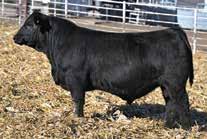













B9 Wyoming Livestock Roundup • Volume 35 No. 45 • March 2, 2024 TRIANGLE J RANCH AND ALTENBURG SUPER BALDY SELECT Colorado Fort Collins, Colorado Centennial Livestock Auction MARCH 16, 2024 SATURDAY 1 PM MT TRIANGLE J RANCH Darby and Annette Line 35355 Arrow Rd., Miller, NE 68858 Phone: 308-457-2505 Cell: 308-627-5085 www.trianglejranch.com ALTENBURG SUPER BALDY Willie and Sharon Altenburg 570 E. County Rd. 64, Fort Collins, CO 80524 Cell: 970-481-2570 willie@rmi.net www.altenburgsuperbaldy.com Broadcasting Real-Time Auctions Bid Live Online SELLING 150 PAP-TESTED BULLS Black and Red Simmental and SimAngus™ TWO successful programs - ONE powerful offering. Triangle J was the #1 ASA registration herd in Nebraska in 2021. Altenburg Super Baldy was the #1 ASA registration herd in Colorado in 2021. Triangle J has purchased the Altenburg herd in it’s entirety and is bringing the 2024 bull sale to you in Fort Collins, Colorado. Don’t miss this event. L323 ASA# 4224018 SimAngus™ TJ ARROWHEAD 263G SON $API 154.3 $TI 95.7 911L ASA# 4216491 SimAngus™ SAS COPPERHEAD G354 SON $API 95.3 $TI 81.7
ASA# 4217084 SimAngus™ KBHR BOLD RULER H152 SON $API 155.6 $TI 88.3
ASA# 4217340 PB SM GIBBS 8025F RANGER SON $API 143.3 $TI 91.9 659L ASA# 4216461
1373L
947L
SimAngus™ HOOK`S EAGLE 6E SON $API 138.7 $TI 94.6
869L ASA# 4217138 PB SM
Standard turn around time is 2 weeks after order placed or art approval. Offer good through March 31st, 2024 1-Color Regular Price NOW 1 case $3.89 pr $3.69 2 cases $3.59 pr $3.39 3-5 cases $3.39 pr $3.19 6-10 cases $3.09 pr $2.89 11-25 cases $2.99 pr $2.79
GIBBS 8025F RANGER SON $API 122.6 $TI 81.4
A&M graduate student grows chickpeas in amended moondust
Vegetative chlorophyll differences – Varying degrees of chlorophyll can be seen in the chickpea moondust study at five weeks. Texas A&M AgriLife photo by Jessica Atkin
Texas
Once considered an oddity, Wagyu is now the fastest-growing breed in America
Wagyu breeders, some of whom are new to the breed and the cattle business, were treated to a special panel during the recent
World Wagyu Conference in San Antonio, Texas, as three of the breed’s founding fathers gathered to reminisce and recall the early days.
Moderated by past American Wagyu Association (AWA) President Pete Eschelman, the panel consisted of Jerry Reeves, PhD



and retiree from the Washington State University Animal Sciences Department; Ray Record, owner of AgriService International and Dr. Albert Wood, oncology and hematology physician.
The first Wagyu
According to Reeves, the first Wagyu came to the U.S. in 1975. While those four bulls – two blacks and two reds – are the foundation of Wagyu genetics in America, it was a number of years before any real interest in the breed began to grow.
In 1988, the state of Washington initiated a program to develop ag products for export to Japan and other Asian countries.
“They found out tariffs and quotas were going to come off meat into Japan in 1991 and Japan could only produce one-third of the meat they needed,” Reeves said. “So, I was lucky enough to be one of the people selected to go there from our university to evaluate how to prepare us for the market.”
Reeves noted he had never heard of Wagyu.
“I saw things I couldn’t imagine. At the slaughter plants, the cattle and carcasses were just phenomenal,” he said. “We didn’t know it at the time, but there were already four bulls in the U.S.”
At the time, the Speaker of the U.S. House of Representatives was from Washington and had previously been the ambassador to Japan. He got Washington State University permission to bring Japanese cattle to the U.S.
“The U.S. was the only place in the world that
The plan was to cross Wagyu genetics with cattle in the U.S. to produce a half-blood product to ship to Japan, which became a successful venture for several ranches.
“We didn’t assume we would be able to sell this to Americans,” he said.
This changed in a big way in 2003 when bovine spongiform encephalopathy was diagnosed in the U.S.
“All of the meat going to Japan stopped,” Reeves recalled. “There was no place for it to go except back into the U.S.”
This took on profound implications because they hadn’t developed a market to sell Wagyu beef or Wagyu cattle in America.
“Most of this meat was sold for 60 cents on the dollar. Nobody wanted it,” Reeves noted.
However, restaurants began getting the beef at a discount and consumers were introduced to Wagyu beef.
“This changed the whole system,” Reeves explained. “We went from trying to be an exporter to consuming our own meat. Basically, we probably have the best market for Wagyu beef in America in the world right now.”
But this was a difficult period for the Wagyu breed.
“We had contracted 2,000 calves and had to come up with the money to pay producers, because we knew if we didn’t, they wouldn’t be there next year. We weren’t even sure we were going to be there,” he said.
“It was the worst of times and the best of times because I think it was the second-best thing to ever happen,” he
because he had a lot of association experience,” Record said.
Scott, who ended up being the first AWA executive director, owned some of the first Charolais that came to the U.S. and was the executive director of the American Paint Horse Association.
“We needed a baseline of cattle to register, so the only place we had to go was the Kobe Beef Producers Incorporated,” Record said.
He asked for the herd book and was handed a bunch of scratches on a 10-column accounting pad.
“This had all of the information on all of the cattle that had been recorded up to this point in time,” he said. “So, Jim and I spent a lot of time going through and trying to make pedigrees out of those. I think we ended up with 180 head of cattle officially in the beginning that we could start with as a base for the association.”
What’s ahead Wood was one of the foundational Wagyu breeders in the 1970s after the first four bulls came to America. He began practicing medicine in Corpus Christi, Texas in the 1970s and bought a ranch soon after.
“We started line breeding and soon ran into problems with inbreeding,” he admitted. “So, when it comes to the small gene pool, we knew we had to get genetics out of Japan – new, fresh genetics.”
But things didn’t go well.
“After many years of blocking the export of Wagyu cattle, the dam broke in Japan in 1993. In 1994, we were able to get three full-blood bulls and eight








Wyoming Livestock Roundup • Volume 35 No. 45 • March 2, 2024 B10 SCHULER red-angus schulerredangus.com • 308-262-0306 Get the Bull Right Every Time! A Better Brand of Bull! 42 nd Annual Bull Sale March 28, 2024 - Bridgeport, NE Selling 160 Registered Red Angus & Schuler Red Composite Bulls All Bulls Evaluated for Fertility, Docility & Foot Structure #4299641 Cornerstone - over 20 sons sell! 18 CED to 117 YW Spread, Great Feet Top 1% Marbling, Best 7% Feed Efficiency #4463653 Jumpstart - first sons sell this March! 2022 High Selling Red Angus Bull 20 CED to 152 YW, Top 1% ADG Ranching Collaboratively: Mastering Public Land Partnerships Monday, February 12, 2024 Energy Innovations: Exploring the Influence of Energy Innovations Monday, March 18, 2024 Leading the Field: Family-Run Businesses, Industry, and Community Leadership Monday, April 1, 2024 Navigating Western Waters: Addressing Water Challenges in the Western Region Monday April 22 2024 2024 Seminar Topics In-person and online options RANCHING IN THE WEST RANCHING IN WEST RANCHING IN THE WEST SEMINAR SERIES OFFERS SEMINAR SERIES OFFERS SEMINAR SERIES OFFERS REAL-WORLD EDUCATION, REAL-WORLD EDUCATION, REAL-WORLD EDUCATION, PEER-TO-PEER LEARNING, PEER-TO-PEER LEARNING, PEER-TO-PEER LEARNING, & INDUSTRY NETWORKING & INDUSTRY NETWORKING & INDUSTRY NETWORKING LEARN GISTER LEARN GISTER LEARN GISTER UWY RMAL R a n c h i n g i n t h e W e s t 2024 Seminar Series
OBITUARIES
Patrick Francis O'Toole
Dec. 6, 1948 – Feb. 25, 2024
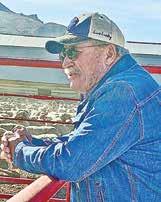
Little Snake River Valley Rancher and Conservationist Patrick Francis O’Toole died Feb. 25, at age 75 of complications following a stroke. He was loved and respected in the agricultural and natural resource communities.
Pat was born Dec. 6, 1948 in Pittsburgh to James Francis O’Toole and Mary Ann Mooney O’Toole. He was proud of his roots, often recounting how all four of his grandparents had immigrated from Ireland to Pittsburgh. When Pat was three years old, his family moved to Hialeah, Fla.
Pat grew up swimming, surfing and most of all, running. He attended Immaculate Conception Catholic School alongside his friend Pete Antonacci, his partner in testing the patience of the nuns.
He attended Hialeah High School – the largest high school in the U.S. – where he excelled in academics, track and crosscountry. He ran a four-anda-half minute mile, but loved distance running.
He attended Arkansas State University, MiamiDade Junior College and Florida State University on track scholarships.
Pat and his friend Pete hitchhiked from Maine to Florida, having many adventures along the way and miss-
ing Woodstock by one exit.
The West called, and Pat moved to Fort Collins, Colo., where he attended Colorado State University (CSU). He met his wife Sharon Salisbury while both were working at The Collegian newspaper. It was there he made lifelong friends with the selfnamed “Porky Dogs.”
Pat graduated from CSU with a bachelor’s degree in philosophy in 1975.
He and Sharon married on Sept. 28, 1975. That winter they traveled throughout South America.
This included traveling by beer and cookie cargo boat 1,500 miles down the Amazon River; celebrating “the People’s Carnival” in Salvador, Bahia, Brazil; visiting Sharon’s sister on a cattle ranch in Brazil; being accosted by a machine-gun toting policeman in Argentina during a revolution; almost getting arrested in Tierra del Fuego during the same revolution and flying in a cargo plane carrying baby chicks.
When they arrived home safely, much to their parents’ relief, they began their life’s work on the Ladder Ranch, along the Wyoming/Colorado border. It has been in Sharon’s family since 1881.
Pat liked to say the ranch raises “cattle, sheep, horses, dogs and children.”
They were accepted at University of Wyoming’s Law School, but decided instead to buy old ewes and embark on a life of animal husbandry. They lived for eight winters in a cabin without electricity or running water and summers in camps as they herded their own sheep.
In 1978, daughter Meghan Lynne was born, followed by Bridget Emma in
APHIS and NAHLN to collaborate
The U.S. Department of Agriculture’s Animal and Plant Health Inspection Service (APHIS) recently announced a collaboration with the National Animal Health Laboratory Network (NAHLN) to bolster national animal health preparedness.
This vital $1 million in funding supports rapid investigations of unexplained morbidity or mortality events (UMEs) in animals – unexpected deaths or illnesses which could signal emerging threats. This proactive approach to surveillance strengthens APHIS’s commitment to safeguarding animal health across the nation.
This cooperative agreement is managed by Michigan State University’s Veterinary Diagnostic Laboratory, a member of NAHLN. The funding will be used to reimburse testing expenses at any NAHLN laboratory for UME cases which meet specific criteria.
Testing is essential to identify causes of illness or death in animals and evaluate potential risks to other animals and public health. By providing funding for UME testing, APHIS is working proactively to identify and address potential disease threats before they become larger, more difficult-to-control outbreaks.
This helps protects animal and public health, along with international trade.
“Early detection and identification of potential threats to animal health is critical to our ability to protect the health of our nation’s animals, the food supply and potentially human health,” said Sara Ahola, APHIS veterinarian medical officer and UME project lead.
1980 and son Patrick Eamon in 1985. Anyone who knew Pat knew of his deep love for his family. He never separated his work life and his family life, drafting them into his projects and passions.
In 1986, Pat was elected to the Wyoming House of Representatives, where he served for six years representing Carbon County. He became known for his gift of working with people in all walks of life, diverse viewpoints and differing political views. He was never partisan, always trying to do the right thing.
Next, he was appointed by President Clinton to the Western Water Policy Commission, looking at the future of water in the West. He wrote the dissenting report defending food production and irrigation.
This led him to the Family Farm Alliance – an organization representing irrigators in 11 Western states. He served as its president from 2005 until his death.
He also proudly served

as a board member of several agricultural and conservation groups, including a stint as chair of the Intermountain West Joint Venture for migratory birds and Partnerscapes, which helped with a fishery and irrigation project on Ladder Ranch’s Battle Creek.
He cared deeply about the Colorado River and was influential in protecting irrigated agriculture, migratory bird habitat and Tribal rights. He was a board member of the Yampa-White-Green Rivers Basin Roundtable, which works on solutions for water issues in Colorado.
He participated in many advocacy groups, both private and public, always speaking out for farmers, ranchers and rural communities.
Pat worked tirelessly to protect his beloved Western landscapes. He and the Ladder Ranch family have been widely recognized for their conservation work and ethic.
In 2014, Ladder Ranch received the prestigious Leopold Conservation Award,
sponsored by the Sand County Foundation and the Wyoming Stock Growers Association.
In 2016, Pat received the Kurt Bucholtz Conservation Award from the Wyoming Stock Growers Land Trust, in recognition of work on water and conservation issues in Wyoming, and in 2022, both he and Sharon were inducted into the Wyoming Agriculture Hall of Fame.
At the time of his death, he was leading a big project –Headwaters of the Colorado. Pat brought together a coalition of diverse stakeholders with the goal of restoring the stressed landscapes of the Routt and Medicine Bow National forests and the contiguous Yampa and Little Snake watersheds. It will be his lasting legacy.
Pat loved the land, and he loved his family completely.
Pat was predeceased by his parents Jim and Marie O’Toole; his in-laws George and Laura Salisbury; his buddy Pete Antonacci and several friends.
He is survived by his wife Sharon; his three children Meghan O’Toole (Brian) Lally, Bridget (Chris Abel) O’Toole and Patrick Eamon (Megan) O’Toole. His six grandchildren were the absolute light of his life. He leaves Siobhan, Seamus, Maeve and Tiarnan Lally and Patrick McCoy O’Toole and Rhen O’Toole.
He is also survived by his sister Mary Lynne O’Toole Lidstone; his niece Sherri Salisbury Marthaller and his nephews Bill Moree, Joe Salisbury, Christian Gros, Kevin Lidstone, James Lidstone and John Lidstone. He also leaves many cousins in Florida and Pennsylvania and a plethora of close friends.
A celebration of life will be held at the Ladder Ranch in July 2024, date to be announced. The family asks donations be made to the Family Farm Alliance, 317 S. 7th Street, Klamath Falls, OR 97601 or the Little Snake River EMS, Box 275, Baggs, WY 82321.



















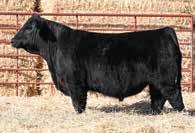




















B11 Wyoming Livestock Roundup • Volume 35 No. 45 • March 2, 2024 Shane & Beth Temple T-HEART RANCH and L-CROSS RANCH www.t-heartranch.com 719-850-3082 • 719-850-3083 shane@t-heartranch.com Follow us on Facebook True High Altitude Cattle T-HEART RANCH Marty Ropp 406-581-7835 Corey Wilkins 256-590-2487 Clint Berry 417-844-1009 Jared Murnin 406-321-1542 www.alliedgeneticresources.com Justin Warren 970-367-0035 SIRE GROUPS INCLUDE: THR Mountain Time 8441F - PAP 37 ASA 3424773 TJ Night Owl 0561H - PAP 38 ASA 3762024 CCR Walker 3355H - PAP 39 ASA 3873028 Redhill Accelerate 23H - PAP 41 ASA 3805276 YOUR #1 SOURCE FOR PAP TESTED GENETICS At T-Heart Ranch we o er more than just a PAP score. We take it a step further in testing every one of our registered cows to ensure we can stack multiple generations of PAP testing to allow our customers to get the most information. Our entire herd lives at high altitude. We are con dent that you are receiving genetics that will ultimately help your program excel in the high country. 200 True High Altitude SimAngus™ and Simmental Bulls T-HEART RANCH L3120 5/8 SM 3/8 AN $API 168 $TI 96 ASA 4247620 - BRIDLE BIT ECLIPSE E744 son. PAP 38 G+ ACE 3476L 5/8 SM 3/8 AN $API 160 $TI 93 ASA 4201722 - REDHILL ACCELERATE 12B 23H son. PAP 40 G+ 3465L 5/8 SM 3/8 AN $API 159 $TI 88 ASA 4202422 - J-J 720E son. PAP 38 G+ ACE 3001L PB SM $API 180 $TI 97 ASA 4211746 - HOOK`S EAGLE 6E son. PAP 39 G+ 3550L 5/8 SM 3/8 AN $API 154 $TI 85 ASA 4202458 - TJ NIGHT OWL 561H son. PAP 39 G+ ACE 3546L 3/4 SM 1/4 AN $API 161 $TI 87 ASA 4201740 - LCRR LITTLE BEAR 0264H son.
39 G+
PAP
COLLEGE’S
ATEC BUILDING, 3401 West C Street, Torrington, WY. Viewing 10:30 a.m. Sale 1 p.m. Up to 16 show lambs, up to 16 show goats, up to 16 show swine. Call 307-799-5419 for more information 3/16
GUN SHOW MARCH 16-17: Weston County Senior Citizens Center, Newcastle, WY, Sat., March 16, 9 a.m.-5 p.m.; Sun., March 17, 9 a.m.-3 p.m.
Admission $5, kids 12 and under free when accompanied by a parent or guardian. Vendor setup Fri., March 15, 3-8 p.m. For more information, call Mike Novotny, 253-6784825 3/9
2024 CACHE VALLEY COWBOY RENDEZVOUS, MARCH
14-17: Welcomes in concert
Ned LeDoux, Wylie Gustafson and Dave Stamey. Free admission to Cowboy Poetry, Western Music, Vendors and Poetry Contests, etc. Fri. 3-10 p.m. and Sat. 10 a.m.-8 p.m. Cache County Event Center, Logan, UT. Go to www.cvcowboy.org or leave message at 435-7600160 3/9

GOTTSCH LIVESTOCK FEEDERS
LLC Red Cloud, NE
Join Our Team! Gottsch Cattle Company, Red Cloud, NE is looking to hire motivated and dependable feed truck drivers. Our full-time benefit package includes: Health, dental, life insurance, health savings account and 401(k). Retention bonus offered to full-time employees.
Incentives paid out at 6 months and 1 year of employment. If you are interested stop by and fill out an application or visit our website at www.gottschcattlecompany.com
Call Russ Weber 402-984-8485 or 402-746-2222 for more information.
RANGE RIDING JOB: Come spend your summer herding cattle for the Caribou Cattlemen’s Grazing Association, located east of Montpelier, ID. This job requires cowboys or cowgirls with a strong work ethic and a desire to tend to cattle on the National Forest. The pay is $3,500 a month. Job is from June 1-October 31, 5 days a week. Responsibilities are packing salt, working with permittees to move cattle, doctoring cattle and keeping cattle where they belong. A cabin is provided with horse pasture. Applicants must have their own horses and tack, (dogs are welcome) and pickup and trailer. If interested contact Dru Haderlie, 307723-0944 or Layne Keetch, 208-540-0634 3/23
EXPERIENCED FARMHAND
WANTED: Year-round employment and benefits. Call 307899-3772, 307-254-5672 or 307-271-1471 3/23

GOTTSCH LIVESTOCK FEEDERS
LLC Red Cloud, NE
Come Join the Gottsch Livestock Feeders Family!
Gottsch Livestock Feeders is looking for Cowboys/Pen Riders for their feedyard in Red Cloud, NE. The main focus of the Cowboy/Pen Riders are spotting, pulling, diagnosing and taking cattle to the hospital and shipping fat cattle. This person will need to be a team player who is seeking a long-term position. You will have the opportunity to work with and learn from some of the best in the industry. We offer a benefits package that includes health insurance, dental, vision, 401(k), health savings, life insurance and paid vacation. Retention bonus offered to full-time employees. Incentives paid out at 6 months and 1 year of employment. If you are interested stop by and fill out an application or visit our website at
www.gottschcattlecompany.com
Call Brandon Furr at 402-257-7769 or 402-746-2222 for more information.
HELP WANTED: Five years plus cattle handling experience. All aspects of ranch operations: Irrigation, haying, feeding, cattle stewardship and horseback skills. Housing, benefits and salary. Only serious, committed candidates should apply. Eastern Oregon cow/calf operation. Send resumes to lisa. steele@pvranch.com 3/23
DEVILS TOWER FOREST
PRODUCTS INC., A LUMBER MANUFACTURER IN HULETT, WY, IS ACCEPTING APPLICATIONS FOR FULL-TIME ELECTRICIAN (PLC EXPERIENCE), BOILER/KILN OPERATOR, MILLWRIGHT, PARTS PROCUREMENT AGENT AND PLANER
FEEDER: Benefit package includes company paid medical and dental insurance (including dependents), life insurance, company-matching 401(k), safety incentives, holiday pay, paid vacation and sign on bonus. Mandatory employment and random drug testing is conducted. EOE. Starting wage D.O.E. Online applications are available at wwww.neimanenterprises. com. E-mail applications to joe.ortner@devilstowerfp. com or fax to 307-467-5418, contact Joe Ortner at 307467-5252 with additional questions 3/2
ASSISTANT SUPERVISOR POSITION AVAILABLE AT LARAMIE COUNTY WEED AND PEST, PINE BLUFFS, WY: This position is full time and open until filled. The position qualifications are available on our website at www. laramiecountyweedandpest. com along with the job application or by calling 307-2453213. Please mail your completed application and resume addressed to Attention: Matt Haas, district supervisor, Laramie County Weed and Pest, 801 Muddy Creek Drive, Pine Bluffs, WY 82082 and clearly marked “job application” on the envelope or by e-mail to lcwpsupervisor@gmail.com. For more information, contact Matt Haas, District Supervisor at 307-256-1979 3/2
Help Wanted
MOUNTAIN RANCH IN COLORADO LOOKING FOR COWBOY ON A YEARLING OUTFIT: Experience roping, doctoring and riding rough terrain preferred. Must be able to work on a team. Housing and benefits included. For more information, call Whit Gates at 970-846-4353 3/23
JOB OPENING: PUBLIC WORKS POSITION FOR THE TOWN OF COKEVILLE. A water level 1 license, a waste water level 1 & 2 and a CDL Class B driver’s license are preferred at the time of hire. Applicant must be able to obtain CDL Class B within 6 months of hire, a water level 1 within 1 year of hire, a waste water level 1 within 1 year of hire and a waste water level 2 within 2 years of hire. $40,000 annual salary with health insurance and Wyoming retirement. To apply, contact Town Clerk at 307-279-3227. Pay is negotiated on experience 3/16
Financial Services
ALL TYPES OF EQUIPMENT AND VEHICLE FINANCING.
Great service!! Great rates!! Call Chuck Brown at C.H. Brown Co., WY LLC, 307-3223232 (office), 307-331-0010 (cell) or e-mail chuckbrown@ wyoming.com 3/2
Services Services

AGRI-ONE FINANCIAL: Farm/ ranch and all commercial loans. RATES AS LOW AS 5%. We have been helping with all aspects of agricultural, commercial financing and management for years.
LET US HELP YOU on a consulting level with management to increase profitability, deal with and fix credit problems and for all your financing needs. WE CARE AND HAVE WORKING PROGRAMS designed for the farmer/rancher and not the banker. Please call Steve, 303-773-3545 or check out our website, www.agrionefinancial.com. I will come to you and get the job done!! 3/23
Brands

OLD WYOMING REGISTERED BRAND, LRC, LSH. Expires January 2029. $3,500. Call 307283-3431 3/16
Cattle
LUTCHKA ANGUS REGISTERED ANGUS BULLS FOR SALE: PAP tested. Performance tested. Top genetics. DNA tested. Home of the Wyoming State Fair Junior and Open Class Champion Angus bull. Celebrating 71 years in business. For more information, call Derek, 970-227-6236 3/9
FOR SALE, 39 HEAD OF FANCY HIGH-ALTITUDE ANGUS BRED COWS to calve in April. Call 307-760-8429, Laramie, WY 3/2
YEARLING ANGUS BULLS: These bulls are grown, not fattened, will get out and cover cows. Many will work on heifers. We will deliver. Call Joe Buseman, 605-351-1535 3/9


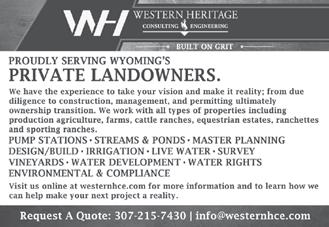
HELP WANTED, FULLTIME EMPLOYMENT FARM/ RANCH OPERATION ● Includes some cattle work
Housing available
Located

STAIRCASE CHAROLAIS AND RED ANGUS ONLINE BULL SALE: 50+ purebred yearling Charolais and Red Angus bulls SELLING APRIL 13-18 Timed auction online with www. DVAuction.com!! Our bulls are bred for balanced traits, functionality, disposition and efficiency to serve the cattle industry every step of the way, from the cow/calf producer all the way to the packer and consumer! For more information, visit www. staircasebulls.com, find us on Facebook or give us a call. Gus, 307-575-5860 or Amy, 308631-1952 4/13

WANTED: PRAIRIE DOGS AND YOTES. Mature (60+), responsible, experienced Iowa hunter seeking ranchers/farmers with excess prairie dogs and/or coyotes. Precision shooting, not lead flinging. Call or text Scott at 319-431-2491 3/23
WANT TO BUY LONGHORN/ CORRIENTE COWS OR HEIFERS: Bred or open. Crossbred would be ok. Must be bangs vaccinated. Call 307921-3593 3/30
Angus



Wyoming Livestock Roundup • Volume 35 No. 45 • March 2, 2024 B12 March 2, 2024 2 307-234-2700 • 1-800-967-1647 • Fax: 307-472-1781 • E-mail: jodym@wylr.net or denise@wylr.net Website: www.wylr.net Weekly Deadline: Wednesday, 12:00 p.m. CLASSIFIEDS VIEW OUR CLASSIFIEDS ONLINE AT www.wylr.net Going, Going, Gone www.torringtonlivestock.com 307-532-3333 Torrington Livestock Markets Notice Events Auctions Help Wanted NOTICE: Publication in this newspaper does not guarantee the legitimacy of any offer or solicitation. Take reasonable steps to evaluate an offer before you send money or provide personal/financial information to an advertiser. If you have questions or believe you have been the victim of fraud, contact the Wyoming Attorney General’s Office, Consumer Protection Unit, 109 Capitol Building, Cheyenne, WY 82002, 307-777-6397 TFN READ IT IN THE ROUNDUP Pump Solar Water Pumping Systems Water Well Services • Well & Pipeline Design Submersible Pump Specialist Parker Blakeley, Owner ppr@pronghornpump.com www.pronghornpump.com • (307) 436-8513 • Service LLC. Angus LANCER LIVESTOCK SALE, SUN., MARCH 24 AT EASTERN WYOMING
All AI bred by these breed leading sires: Executive Order, Epic, Bank On It, TJ Gold, Beacon, Right Now, Big Casino, Home Town, Fail Safe, True North, Alternative. Many bulls suitable for heifers. Backed by 46 years of AI & ET genetics. PAP tested. Cattle Raised by Cattlemen for Cattlemen in a Real World Environment at 8,000’ - 9,000’ Elevation Monday, March 11, 2024 • Cowboy Auction - 1 p.m. • Riverton, WY Pete & Lynnda Thompson Lynnda 307-709-8361 Big Piney & Riverton, WY P\T Livestock Annual High Country Genetics Performance Bull Sale Selling 60 Angus, SimAngus & Simmental Bulls Financial Services RegisteRed Angus Bulls P rivate t reaty and F rontier L ive Bridger, MT O pening D ay Saturday Louis & Kathy Dubs • Billings, MT 406-652-7515 • 406-208-8643 windingriverangus@gmail.com Sires Include: Resilient • Iron Horse • Man in Black Thedford • Value Added • Movin On Many suitable for heifers. March 16, 2024 Also see our pen of 6 bulls at Midland Bull Test. Angus
Help Wanted Cattle
●
●
on school bus route ●
negotiable ● Located in western North Dakota. Call 701570-6703 3/2
Wages
RED ANGUS HIGH-ELEVATION
YEARLING BULLS FOR SALE
IN NORTHEASTERN UTAH: Out of AI and bull-bred sires. Will be trich, semen tested and fed for free until May 1. $2,500/head. Bar Lazy TL Ranch, David, 435-828-1320, barlazytlranch@ gmail.com 6/30
SimAngus
SIMANGUS BULLS FOR SALE:
18-month-olds and yearlings. Sired by TJ Chief, Tehama Tahoe, TJ Big Easy, TJ Flatiron, MR SR Highlife, EWA Peyton or sons of TJ Main Event and SAV Rainfall. Call James Dilka/Dilka Cattle, 970-396-8791, thedilkas@aol. com 3/23
SIMANGUS YEARLING AND FALL-BORN BULLS AVAILABLE PRIVATE TREATY: Great dispositions. Black and BWF bulls available for cows and heifers. Bulls will be semen checked and ready to go. Quantity discounts. Call Rob at Schultz Farms, 308390-3612 3/2
Hereford
BROWN SWISS BRED HEIFERS FOR SALE: Will calve March, April and a few in May. Bred to Brown Swiss bulls, most are AI’d and some live covered. Have had all shots. Poured with Ivomec on regular basis. TB tested and current health papers. Nice, gentle, outside cattle, in good shape and well fed. Delivery options available. For pictures or more information, call Robin Carlson, 605224-6100, if no answer leave message. Pierre, S.D. To view photos, go to www.wylr.net in the classifieds 3/23


Seed
PASTURE WANTED: I am looking for a ranch lease or summer pasture lease for 250500 pairs. Call Joe, 605-8302210, jrcredangus@yahoo. com 3/23
SUMMER PASTURE NEEDED FOR 50 COW/CALF PAIRS. Good references. Call 605-3473403 or 605-499-9088 3/2
PASTURE WANTED FOR 160 PAIRS: Can be separated. South-central Montana or northern Wyoming preferred. References available. Call 406-8712428 3/2
PASTURE WANTED for 2,000 yearlings and 500 pairs. Can split into smaller bunches. Call 701-523-1235 3/9
Ranch Lease Wanted
OPEN POLLINATED SEED CORN out produces hybrid for silage and grazing quality grain, $67/bushel +S/H. Call 217-857-3377 or cell/text 217343-4962, visit website www. borriesopenpollinatedseedcorn.com 3/23
GRASS SEED FOR SALE: Manifest wheatgrass and Cache Meadow brome, good germination, $3/lb. Call Big Horn Seed Company, 307-202-0704 or 307-645-3322 3/2
600+ TONS OF GRASS HAY FOR SALE. ALSO HAVE grass/ alfalfa mix and alfalfa hay, cow and barn stored. WHEAT HAY, OAT HAY AND STRAW. Small squares, 3x3s, 3x4s and round bales. Delivery available!! Large quantities still available. Call today for best price, 307-6303046 3/23
SHELL CORN FOR SALE: Very good feed value. For more information, call 307-754-5864 3/2 800 TONS NICE, green grass/alfalfa mix (80/20); 600 TONS MIX with rain and/or weeds (cow/grinding hay); 300 TONS GRASS HAY, green; 1,000 TONS TRITICALE HAY, mostly green, some with rain; SEVERAL LOADS MILLET HAY, nice!! All types, mostly round bales, some 3x4/4x4. Delivery available. Please call 307-6303768. Marketed by the Cheyenne, WY area producer 3/16
2023 ALFALFA AND ALFALFA/GRASS MIX HAY, 3x3 bales barn stored. ALSO, SOME FEEDER HAY and BARLEY STRAW available. Call 307350-0350, Farson, WY 3/2 HAY FOR SALE: 200 tons left of first crop hay with protein ranging between 19.7% and 22.4%, baled mature, but not rained on, bales weigh between 1,500-1,650 lbs., $160/ton. 400 tons of second crop hay with protein around 21%, baled without rain damage, bales weigh around 1,650-1,800 lbs., $180/ ton. ALSO, 200 tons of straw left, bales weigh approximately 1,100 lbs., certified weed free, $75/ton. All bales are 4x4x8 in size. Location between Lovell and Powell, WY. Contact 307272-3712 3/2
CERTIFIED WEED-FREE
PURE ALFALFA HAY: Small squares, all covered. First, second and third cutting available. Will load trucks and any open trailer. OATS: Combine run. Will auger into truck, trailer or large totes/ag bags. STRAW: Small squares available. Located between Powell and Cody, WY. Call or text Knopp Farms at 307-254-0554 3/2

Look to CRR Baldie Makers... ...Proven to Increase your Bottom Line. COYOTE
Evans Cornelius
Jane



RIDGE
Hampton Cornelius


YEARLING POLLED HEREFORD BULLS FOR SALE
BORDER COLLIE PUPPIES FOR SALE: Great bloodlines, out of excellent working parents. Born Feb. 1, $500. Call 307-6453130 3/2
LIVESTOCK GUARDIAN DOG PUPPIES, ANATOLIAN SHEPHERD/BERNESE MOUNTAIN DOG/GREAT PYRENEES
DO YOU WANT TO RETIRE AT THE TOP OF THIS MARKET AND KNOW YOUR LAND IS IN GOOD HANDS? Regen, LLC is a business that provides for ranchers/landowners the service of professional ranch management. We work to understand your needs on your ranch and provide a professional management team tenancy where you no longer need to worry about the work, get paid competitive rent and can keep the ranch legacy intact. Instead of selling, please consider renting the ranch to our team. We are a family business, based in Wyoming and with expertise in all arrangements of federal, state and deeded land and work every day to accomplish our mission. We steward land with regenerative principles, where animals thrive by connecting rich heritage to vibrant futures. Call Sage, 307-3514875 or e-mail at saskin12@ gmail.com 5/11
Land for Lease
180 IRRIGATED ACRES FOR LEASE IN POWELL, WY: Would make good stock or grain/hay operation, Willwood Irrigation. Pasture for 30-60 head of cows. Call 307-2192217 or 719-217-8054 3/2
Horses
Seed
LOTS OF GRASS HAY FOR SALE, 1,200 lb. 3x4x8 bales. Cow and horse hay, $150/ton. Southwest WY. Call Kelly, 307-7807027 3/9
Seed
Warner Ranch Seed
Serving Fremont County, Wyoming and the surrounding areas.

HarvXtra® alfalfa with Roundup Ready® technology, Roundup Ready® alfalfa and conventional varieties available!
Plant the best!
Buffalo Brand Seed for annual forages, cover crops, pasture grasses, small grains and custom mixes.

Bryan Warner • 307-850-7668 (cell)
Sugarbeet Shares
Hay & Feed
VALLEY VIDEO HAY MARKETS, LLC: Ranch hay consignments available now $130$160, rounds and squares alfalfa. Lusk and Torrington, WY. Scottsbluff and Lyman, NE. Go to www.valleyvideohay.com or call Barry McRea, 308-2355386 3/2
BARLEY HAY FOR SALE. Call 307-851-4532 3/2
CERTIFIED BARLEY STRAW FOR SALE, 3x4 bales. Cody, WY. Call 307-899-1952 TFN
Vehicles & Trailers
2017 F350, SRW, 72,000 miles, very good condition WITH 679 9’ DEWEZE BALE BED. Full bumper grill guard replacement. $59,500. Call 307-680-1561 3/2
Vehicles Wanted
WANT TO BUY: 1980’S ERA
FORD F-350 TRUCK. With or without motor. 1980 to 1986 year preferred. Flatbed and dually preferred. Call Eric at 307696-9930 3/23
WANTED!!! 1932, 1933 or 1934 Ford car project, unrestored or restored. Call 605290-3208 3/2
Equipment


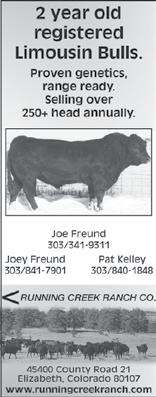
MIX: Puppies will be 85-120 lbs. at maturity. These puppies are raised on a ranch and are highly socialized with 3 young children (ages 5, 7 and 9), adult dogs and chickens. These dogs are awesome with protective livestock guardian instincts, high intelligence and, with proper training, make great family dogs. Large backyard or acreage a requirement. Puppies 11 weeks old and immediately ready for new homes. Dewormed, vaccinated and come with a transponder chip kit, $550. Call Tyler Toth, 303-828-6397, e-mail tlrtoth@gmail.com. To view photos, go to www.wylr. net in the classifieds 3/16
AIREDALE TERRIER OORANG PUPPIES: AKC registered, will be large calm protective dogs. Great farm/ranch protectors from mountain lions, bears, coyotes, vermin... For more information, call 307-2192217 3/16
WE HAVE A LITTER OF GREAT PYRENEES LIVESTOCK GUARD DOGS: Two males, ready to go now. They’ve been exposed to various types of livestock. Have sweet and loving personalities. $150/pup. For more information, contact Casey or Cristy Davis, 605-431-2067 or 605206-0495 3/9
BEST OF THE BIG HORNS HORSE SALE, APRIL 13, Buffalo Livestock Marketing, 44 TW Rd., Buffalo, WY. Online bidding through www.cattleusa. com, register 3 days prior to sale. Contact Ellen Allemand, 307-751-8969 or Kay Lynn Allen, 406-697-5882. Visit us on Facebook for updates 4/6
Sheep
MOFFAT COUNTY SHEEP SHEARING SCHOOL, CRAIG, CO APRIL 12-14: This 3-day shearing school provides handson, instructed experience in shearing sheep and an introduction to equipment maintenance. No previous experience needed. E-mail megan.stetson@colostate.edu or call 970-826-3402 for registration information and questions 3/2
WESTERN SUGAR COOPERATIVE BEET SHARES, Lovell District permanent or temporary transfers. Call 307-272-4384 for more information 3/16
Hay & Feed
2023 ALFALFA/GRASS HAY: Large rounds, net wrapped. ALSO, 2023 OAT HAY, large rounds, net wrapped. Scale on site. Near Rapid City, S.D. Call 605-786-3272 (cell) or 605-7875373 (landline) 3/23
2023 OAT HAY FOR SALE: Good and green with lots of oats, 1,500 lb. round bales, plastic twine. Tested low in nitrates. $110/ ton, 45 miles west of Fort Pierre, S.D. Call 605-224-6100, if no answer leave message 3/30
100 TONS ALFALFA HAY: Big round 1,400 lb. bales, $165/ ton. 100 TONS OATS/25% BEARDLESS TRITICALE MIX, big round 1,400 lb. bales, $150/ ton. Call 308-778-6104 3/23
ROUND BALES, QUALITY
GRASS HAY FOR SALE, bales weigh approximately 1,300 lbs. each, Laramie, WY. Call 307-7608429 3/9
GOOD QUALITY OAT HAY: 3x4 bales. Barn stored $145/ton. Outside $120/ton. Tests available, Lusk, WY. Call Paul Hicks, 970203-5019 3/16
ROUND BALED GRASS HAY FOR SALE: Cody, WY area, 1,000 lb. net-wrapped bales, $70/bale. Call, don’t text, Anthony at 307-254-2645 3/2
CERTIFIED ALFALFA HAY FOR SALE: Certified string on hay, 3x3 bales. 65 tons first crop and 55 tons second crop. No weather damage, under cover. Call for pricing, Pavillion, WY. Ranch phone 307856-1226, if no answer, leave a message 3/9
285 PLUS TONS OF 2023
GRASS HAY: 3x4, $175/ton, Encampment, WY. Call 307321-1444 TFN
FOR SALE: Notch 24’ portable ground hay feeder. 12’x24’ heavy duty bale hauler. 12’x40’ portable calving shed with 4 pens, on steel skids for easy moving. Phoenix H14 42’ rotary harrow. John Deere 235 24’ tandem disk. H&S 7+4 17’ and 16’ chuckwagons with bunk feeding extensions and tandem 14 ton running gear. Meyer 18’ chuckwagon with bunk feeding extensions and 14 ton gear, very nice. Two John Deere 716A chuckwagons with John Deere running gear and bunk feeding extensions, been shedded, nice condition. John Deere 158 loader. Danuser post hole digger with 12” bit. Big Valley cattle working chute with automatic headgate. Lorenz 16’x29’ stack mover. 12’ box scraper. SnoMachine 8’ snowblower with hydraulic spout. All in very nice condition!! Call 605-9995482 3/9
call 307271-1014 8/3
BARLEY STRAW: Certified weed-free small squares, $4/ bale. ALSO, 5x6 round bales, $125/ton. GRAIN/OATS, $20/ cwt. Greybull, WY area. Call 307-762-3878 or 307-899-4714, leave message 3/23
300 TONS SUDANGRASS FOR SALE, NOT SORGUM SUDAN Light rain. Most stored under shed. 3x4s, 1,100 lb. average. Great ration mixer. Extend your good hay. Riverton, WY area. Delivery available. Call 307-709-6290 3/2
B13 Wyoming Livestock Roundup • Volume 35 No. 45 • March 2, 2024 Wyoming Livestock Roundup 3 Advertise Your Sheep Here 800-967-1647 Ads Continue on the Following Page Have Seed to Sell? Advertise here! 2-Year-Old Registered Limousin Bulls Joe Freund 303/341-9311 Joey Freund 303/475-6062 Pat Kelley 303/840-1848 Newell, S.D. A veteran owned company. 605-456-2230 Limousin EVALUATING NEW LEASES AND PARTNERING WITH NEW LANDOWNERS UNTIL APRIL 1 Minimum 7 year lease since we will invest in livestock water development and add pivots to flood irrigated ground. Call/text 307-429-8878. SELL YOUR COWS AND COMBINES WHILE THE MARKET IS HIGH Secure reliable income during retirement while keeping land in your family. Swine Hay & Feed ALFALFA HAY FOR SALE 1st and 2nd Cutting Tarped 3x4 Bales Also Clean Wheat Straw Bozeman, MT (406) 600-4146 Meat Processing Red Angus Monday, April 1, 2024 at the ranch Arthur, NE Annual Bull Sale 80 Head of Polled Hereford and Red Angus Bulls Bernie & Stacie Buzanowski 308-726-2138, 406-855-8288 Pasture Wanted Ranch Lease Wanted WEANER PIGS FOR SALE, located in Powell, WY. For more information,
Hay & Feed
Call Today!
PRIVATE TREATY: Forty-five year breeding program, bred to produce top baldy calves. Balanced trait genetics. Reasonably priced. See us on the web at www.mcmurrycattle. com, for pedigrees, photos and videos. BUY NOW! Call 406-254-1247 (house), leave message or 406-697-4040 (cell). E-mail mcmurrycattle@gmail.com 3/23 See Bull Info & Videos on Website & Facebook Polled & Horned Hereford Bulls - Private Treaty Sale
970-371-0500
970-396-2935 18300 CO RD. 43 ~ La Salle, CO 80645
RANCH Katie Cornelius & Lee Mayo 970-396-8320
& Nurse Cows
CRR Herefords Good for your Business
www.coyoteridgeherefords.com Family
Dogs
Livestock Equipment
Rupp
Livestock Equipment
Pipe Pipe
Rupp Hydraulic Calf Tables
Hydraulic Calf Tables $5,250

• Handles Calves up to 300 lbs.
• Handles Calves up to 300 lbs.
• Operates off tractor, bale bed or remote hydraulic unit.
• Operates off tractor, bale bed or remote hydraulic unit.
Call Kevin McClurg, Big Horn Livestock Services 307-751-1828 • bighornlivestock.com
Call Darin Coyle, Big Horn Livestock Services, Inc. 307-851-1634 • www.bighornlivestock.com


Fencing

LODGEPOLE PRODUCTS, 307-742-6992, SERVING AGRI-BUSINESSES SINCE
1975!! Treated posts, corral poles, buck-and-rail, western rail, fence stays, rough-sawn lumber, bedding. SEE US at www.lodgepoleproducts. com and click our “Picking A Fence Post” tab to see why folks choose our posts!! TFN
“The man who stops advertising to save money is like the man who stops the clock to save time”

Fencing

Irrigation Systems
The choice is simple.
Easier On You.
Pipe
PIPE FOR SALE!! 2 7/8”, 3 1/2” tubing, 4” drill pipe, 4 1/2” casing, 5” casing, 7” casing. Rods 3/4”, 7/8” and 1” located in Montana, can ship anywhere. Call Mike, 602-7584447. To view photos, go to www.wylr.net in the classifieds 4/20
OILFIELD PIPE: PRICE REDUCED!! RPJ Enterprises, Inc. 2 3/8” and 2 7/8” is available. Used for fencing, corrals, cattle guards, etc. 2 3/8” and 2 7/8” are on average 31.5’ long per joint. Pierce, CO. Call for details, 970-3244580 7/27

Property for Rent
CASH RENTER WANTED:
The West Nebraska Joint Water Board is taking bids for cash rent on the farming of 162 acres of dryland grass. A specific outline of what is expected can be obtained at the Village of Lyman Office located at 414 Jeffers Ave. in Lyman, NE. DEADLINE FOR
SUBMITTING BIDS WILL BE
APRIL 15 at 3:30 p.m. Bids will be opened on April 16 at the Village of Lyman meeting room at 414 Jeffers Ave., Lyman NE at 6 p.m. Any questions can be directed to WNJWB Clerk, Kim Robb, 308-787-1444 3/16
Hunting &


Big Horn Truck and Equipment Manderson, WY rairdenjlw@tritel.net • 800-770-6280
USED IRRIGATION PIVOTS FOR SALE FROM LEADING
BRANDS: Valley, Zimmatic, Reinke, and T-L. Visit website www.zimmag.com Current available used inventory
● 2021 Zimmatic 8500 7 tower
1,297+ ● 2020 Zimmatic 8500 7 tower 1,297+ ● 2020 ZIMMATIC 8500 8 tower 1,296+ ● 2003 Zimmatic Gen II 7 tower
1,295+ ● 2013 Valley 7000 7 tower 1,336+ ● 2014 T-L Corner Arm only. Call 402-9103236 3/16
FOR SALE: 1,360 ft. of 6” aluminum pipe and 2,250 ft. of 8” gated PVC pipe. Call 308-2493415, Potter, NE 3/23
Irrigation Irrigation Property for Sale
OREGON RANCH, Baker City, Baker County, OR. The Alder Creek pasture contains over 2,000 acres of native spring, summer and fall pasture. The rangeland is situated just east of Baker City, OR. The property is in good condition and has good perimeter fencing. The range is gently south facing slope with a variety of native grass. FIRST TIME OFFERING at just over $500 per acre for deeded and contiguous ownership, $1,095,000. Give us a call at 541-523-4434, Intermountain Realty, Inc., Greg Sackos, Principal Broker, James Dunlap, Broker, www.intermountainland. com 3/23
Property for Sale
WILKES RANCH is a great opportunity to own a thriving crop and cattle ranch in Goshen County, WY. Includes a nice home, livestock barn and center pivot. This property is well-equipped to support optimal crop and hay production, as well as efficient cattle rotation. Located near Hawk Springs, WY. $800,000. Pictures and video at www. buyaranch.com. Call Casey Essert, Land Broker, 307532-1750 3/2
66.856 ACRES, JUST NORTHWEST OF RED LODGE, MT BORDERING THE GOLF COURSE: This property is presently agriculturally zoned, current use is hay and pasture and it is fenced and cross fenced. Enjoy views of several mountain ranges and lots of water, including Spring Creek frontage, mature trees and lush grass. Could be zoned commercially, allowing for development of a number of homesites and/or other commercial ventures. This property is simply loaded with possibilities. Access is off Willow Creek Road. DNRC Right Nos. 43D 216331-00 and 43D 200020-00, Pryde Ditch and West Fork of Rock Creek. $2,300,000. Property to be shown by appointment only and listing agent shall accompany all showings. Sellers ask that prospective buyers respect their privacy. Call Bill at 406-698-9266 for a tour of this parcel TFN
Property Wanted
FREE GRAZING RIGHTS!! My wife, two kids and I would like to purchase 150-500 acres in the Big Horn Mountains for recreational purposes, (western slope preferred). Seasonal water a must!! We like to camp, hunt and fish... YOU KEEP GRAZING!! Text, call or e-mail me, 307218-4866, william.neighbors@ gmail.com 3/9


MARCH 7-10: PETSKA FUR WILL BE BUYING ALL RAW/ DRY FUR DEER/ELK HIDES AND ANTLER IN THE FOLLOWING TOWNS AND LOCATIONS: MARCH 7: Douglas 6:45-7 a.m., Douglas Feed (drive thru, call/text Greg); Bill 7:30-7:40 a.m., Bill’s Store (drive thru, call/ text Greg); Wright 8:20-8:40 a.m., Exxon Big D on S. 387; Newcastle 10:20-10:50 a.m., Voelker’s Body Shop; Sundance 11:40 a.m.-12 p.m., Rapid Stop; Moorcroft 12:40-1 p.m., The Coffee Cup; Gillette 1:30-1:50 p.m., T&T Guns and Ammo; Gillette 2:152:45 p.m., Rocky Mountain Sports. MARCH 8: Sheridan 7:10-7:50 a.m., Sportsman’s Warehouse; Buffalo 9-9:20 a.m., Good 2 Go; Ten Sleep 11-11:30 a.m., Pony Express; Hyattville 12:10-12:30 p.m., Paint Rock Processing; Manderson 12:50-1 p.m., Hiway Bar (drive thru, call/text Greg); Basin 1:15-1:30 p.m., Overland Express Mart (drive thru); Greybull 1:45-2 p.m., Overland Express Mart (drive thru); Lovell 2:40-3 p.m., Good 2 Go; Powell 3:30-3:50 p.m., Murdoch’s; Cody 4:30-5 p.m., Nature’s Design Taxidermy. MARCH 9: Meeteetse 6:50-7 a.m., Elk Horn Bar (drive thru, call/text Greg); Worland 8:10-8:40 a.m., Coop One Stop; Thermopolis 9:209:50 a.m., Renegade Guns; Shoshoni 10:20-10:40 a.m., Fast Lane (NW corner, drive thru); Riverton 11-11:45 a.m., Vic’s Body Shop (behind the Dollar Tree); Hudson 1212:15 p.m., Wyoming Custom Meats (drive thru, call/ text Greg); Lander 12:30-1 p.m., Zander’s One Stop; Jeffrey City 2:15-2:30 p.m., Split Rock Café (drive thru, call/ text Greg); Muddy Gap 3 p.m., truck stop (drive thru, call/ text Greg); Casper 4:10-4:50 p.m., Wagner Outdoor Sports. MARCH 10: Glenrock 6:50-7 a.m., east exit on I-25; Douglas 7:30-7:50 a.m., Douglas Feed; Orin Junction 8:40-8:50 a.m., truck stop (drive thru); Lost Springs 9:20-9:40 a.m., Main St. (drive thru, call/text Greg); Lusk 10:15-10:35 a.m., Decker’s Grocery; Mullen, NE 3:15-3:30 p.m., Chuckwagon (drive thru, call/text Greg). For more information, call Greg, 308-750-0700 or visit www.petskafur.net 3/2

UNL Extension educator offers tips for calving in muddy conditions
Cold, wet winter weather has arrived just in time for many producers across the West to start calving, and University of Nebraska-Lincoln (UNL) Extension Beef Educator Dr. Lindsay WaechterMead reminds cattlemen to stay alert when welcoming calves in muddy conditions.
“Muddy conditions in calving areas can lead to health concerns in both the cow and calf,” she states, further noting mud and moisture can prevent an animal’s hide from insulating, resulting in difficulty maintaining body temperature and
ultimately leaving calves vulnerable to hypothermia and cows vulnerable to reduced body condition.
In an article published by UNL on Feb. 15, Waechter-Mead notes although muddy conditions often can’t be avoided, management strategies to help cows and calves stay clean and dry can make a big difference in their overall health and survival.
season. In wet conditions, the presence of mud and fecal material on udders increases the risk of calves ingesting diseasecausing pathogens when they nurse.
“Environmental pathogens amplify with each new animal introduced to the calving area,” Waechter-Mead states.
cepts – calves are born in a clean area to minimize the number of pathogens in the environment at birth and calves are grouped by similar ages to prevent direct contact between younger and older calves.
gests stringing hot wires to block off certain corners of a pen or building shelters with creep panels.
“It is important to monitor these areas often and remove soiled bedding to prevent the spread of disease,” she notes.
for cows to calve without contamination of udders and navels,” WaechterMead says. “Again, this area needs to be monitored closely and refreshed often to minimize disease risk.”
Preventing the spread of
scours
As many cattlemen know, preventing the spread of scours is absolutely critical throughout the course of calving
Therefore, she goes on to mention the popular Sandhills Calving Method, which can be modified to individual systems in order to minimize the instance and impact of these pathogens.
This methodology includes two key con-
“Keeping age groups together is one way to minimize the risk of exposure to large amounts of disease-causing agents,” she says.
Utilizing calf shelters
Utilizing calf escape areas and shelters to keep out cow traffic can also help reduce the accumulation of mud and pathogen load.
Waechter-Mead sug-
Preventing naval ill
Clean, dry bedding is also crucial for minimizing the risk of naval ill, which occurs when bacteria from a contaminated environment enters a newborn calf’s naval, creating abscess or infection.
“Bedding such as round straw bales or cornstalks behind wind shelters will provide areas
Producers are also encouraged to spray or dip newborn calves’ navels with a disinfecting liquid, such as a seven percent tincture of iodine to promote drying and healing of the umbilical cord.
Hannah Bugas is the managing editor of the Wyoming Livestock Roundup. Send comments on this article to roundup@wylr.net.
Wyoming Livestock Roundup • Volume 35 No. 45 • March 2, 2024 B14 March 2, 2024 4 THE ROUNDUP GETS RESULTS TANK COATINGS ROOF COATINGS Available for METAL, composition shingles or tar roofs. Long lasting and easy to apply. We also manufacture tank coatings for concrete, rock, steel, galvanized or mobile tanks. VIRDEN PERMA-BILT CO. 806-352-2761 www.virdenproducts.com Call for our free catalog: Scan the QR Code with your mobile device to visit our website! Roof Coating Three Crown Petroleum P.O. Box 774327 • Steamboat Springs, CO 80477 We Buy or Lease Minerals 970-756-4747 hcooper@ipcoilandgas.com www.threecrownpetroleum.com Fax: 970-457-5555 Mineral Rights Mineral Rights
Fishing PIPE FOR SALE!!
in Montana, can ship anywhere.
Mike • 602-758-4447
2 7/8”, 3 1/2” tubing, 4" drill pipe, 4 1/2" casing, 5" casing, 7" casing. Rods 3/4", 7/8” and 1" located
Call
Used guardrail for sale!! Great for fencing! Thrie-beam & W-beam; 20” & 12” wide panels by 13.5’ long. Truckload quantities available; delivered to your location.
Call Keegan • (208) 775 - 0135
The American Sugarbeet Growers Association (ASGA) was created to unite sugarbeet growers in the U.S. and promote the common interest of state and regional beet grower associations, which include legislative and international representation and public relations.
ASGA represents thousands of family farmers in top producing states, including California, Colorado, Idaho, Michigan, Minnesota, Montana, Nebraska, North Dakota, Oregon, Washington and Wyoming.
During the annual convention held in Orlando, Fla. on Feb. 5-6 participants discussed a variety of topics impacting the future of the sugarbeet industry, including the 2024 election, sugar as part of a healthy diet, sugar markets and funding for ag research.
Hot topics
To kick off the event, David Wasserman, senior editor and elections analyst for “The Cook Report” and analyst for NBC News, discusses what he believes the coming 2024 elections for the White House, the Senate and the House of Representatives may look like.
Sugar Association President and Chief Executive Officer Courtney Gaine offers updates on consumer trends relating to sugar consumption and public health policy associated to recommendations for sugar consumption.
“Overall consumers are trying to moderate their sugar intake, but they are not looking to replace sugar with artificial sweeteners,” she notes. “Consumers have kind of moved on from sugar being public enemy number one.”
She says the Sugar Association is advocating for sugar on several fronts in regards to U.S. policy, including making sure sugar guidelines are not contradictory and that they make sense.
“The Sugar Association plans to continue its ‘Real Sugar’ messaging campaign about sugar being a natural, plant-based product and to launch a new campaign with the messaging, ‘Life is sweet. Keep it balanced,’” she explains. “This is to promote how sugar can be part of an enjoyable and healthy diet and to explain dietary guidelines for sugar.”
“It’s our message to drink responsibly, but we’re also correcting the narrative you can consume a lot less sugar than you actually can,” she concludes.
Sugar policy and trade markets
On the policy front, Dylan Daniels, senior policy advisor with the U.S. Department of Agriculture’s (USDA) Foreign Agricultural Service’s Trade and Foreign Agricultural Affairs, and Carlann Unger, economist with the USDA Farm Production and Conservation’s Economic and Policy Analysis Division,
explains how the sugar program is managed and what may cause challenges.
Unger presents the January 2024 World Agriculture Supply and Demand Estimates Report, illustrating how the U.S. remains a consistent stocks-touse ratio for sugar and discussed what types of imports are coming into the U.S., including “high-tier” imports which are charged a higher tariff.
“With world sugar prices driving domestic sugar prices up, it can make economic sense for users to bring in high-tier sugar,” she explains.
Daniels traces the history of sugar policy in the U.S., going all the way back to colonial times and explains the modernday tariff-rate quota system, which determines how much sugar can come in to the U.S. and from which countries before tariffs go into effect.
“Over the years, the world sugar picture has changed while the U.S. system of allocations under the tariff rate quota system has stayed the same, meaning several countries on the U.S. allocation list either no longer produce sugar or no longer export sugar to the U.S.,” he adds.
American Sugar Alliance Director of Economic and Policy Analysis
Rob Johansson says market fundamentals suggest high global sugar prices will continue and discusses sugar markets, their impact and perceptions of the sugar program.
Johansson says it appeared factors leading to high sugar prices were continuing due to tight global supplies.
“One factor that could change things would be if fuel prices reach a point where farmers living in countries where sugar is used as a source of ethanol decide to sell into the sugar market,” he remarks.
He notes he believes USDA has managed the sugar program well and addressed the concern sugar was contributing to food inflation.
However, he says there is no connection between wholesale sugar prices and food companies’ fees.
Supporting future research
“The U.S. is a leader in doing more with less in agriculture because of past public investments in research,” says Rebecca Larson, chief scientist and vice president of government affairs for the Western Sugar Company.
However, public spending on research in the U.S. has declined sharply, and Larson wants to figure out how to make research funding more flexible to ensure money goes to the highestimpact projects which have the best chance of making it to the farm.
USDA Agricultural Research Service (ARS)
Northern Crop Science Laboratory Research Manager and Plant Pathologist Melvin Bolton provides updates on the Sustainable Sugar Beet Research Initiative, which involves a competitive process in which scientists from anywhere can apply for funding for projects that are then evaluated based on merit and impact on the industry.
“What’s special about this program is while we have funding, we actually distribute it to the U.S. at large to every university, even to private companies



and ARS researchers, to work on a variety of priority areas the industry thinks are important,” Bolton states.
This approach is important to meet the real needs of farmers, results are already leading to real solutions to problems such as Cercospora and other beet diseases, resistant weeds, beet storage and the use of sugarbeet cover crops in crop rotations.
ASGA Executive Vice President Luther Markwart adds, “The work done by scientists over time has made a big difference





in agriculture, including improving the yields and sugar content, as they are very passionate about what they do.”
Wrapping up the twoday event, Markwart and Zack Clark, vice president of government affairs for ASGA, explains what the organization and its political action committee have been working on in the past year.
“We have been advocating for changes in policy in the farm bill, advocating against harmful changes brought up by opponents



of sugar policy, including one proposal that made its way to the floor of the U.S. House and educating lawmakers and regulators about the importance of U.S. sugar and a strong sugar program,” Clark concludes.
Today, the U.S. sugar industry employs 151,000 people in 22 states and has an annual economic impact of nearly $23 billion on the nation’s economy.
Melissa Anderson is the editor of the Wyoming Livestock Roundup. Send comments on this article to roundup@wylr.net.


























































B15 Wyoming Livestock Roundup • Volume 35 No. 45 • March 2, 2024 The LaFollette Family Powell, Wyoming Quin 307-899-3553 Gavin 307-899-1764 info@blacksummitcattle.com Wh e ca le that p f m g the ribb . Marty Ropp 406-581-7835 Corey Wilkins 256-590-2487 Jared Murnin 406-321-1542 www.alliedgeneticresources.com Bu Sale Black Summit Cattle Sale Facility || 1476 Hwy 14A, Powell, WY 82435 FRIDAY 1:00 PM MARCH 15 ANNUAL 80 SIMANGUS BULLS developed on “THE HILL” PAP TESTED PERFORMANCE TESTED BVD TESTED RIGHT CHOICE VERIFIED Homo Black, Homo Polled SimAngus™ $API 164 $TI 86 GW JOURNEYMAN 851H son. 381L ASA 4206442 G+ Homo Black, Homo Polled SimAngus™ $API 183 $TI 104 GIBBS FAST TRACK 0634H son. 303L ASA 4206364 G+ Homo Black, Homo Polled SimAngus™ $API 155 $TI 89 CLRS HOMELAND 327H son. 366L ASA 4206427 G+ Homo Black, Homo Polled SimAngus™ $API 151 $TI 93 CLRS HOMELAND 327H son. 369L ASA 4206430 G+ ATM Homo Black, Homo Polled SimAngus™ $API 157 $TI 92 CCR COMMANDER 4404H son. 385L ASA 4206446 G+ O gu t y ha in s. FOR A SALEBOOK, EMAIL INFO@BLACKSUMMITCATTLE.COM
commemorates
better
2024
ASGA
building a
future at
convention
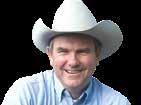

For years we’ve been told by wolf-loving bureaucrats wolves don’t attack people. So, why did Colorado Parks and Wildlife (CPW) publish a pamphlet prior to the reintroduction of wolves into Colorado on the best ways to avoid being attacked and eaten by these lovable creatures?
by Lee Pitts
Below are some of the included suggestions on how to avoid being assaulted.
1. CPW advises when in wolf country, make lots of noise so as to not surprise the wildlife. I’d recommend playing something really irritating and off-putting on your phone that might scare
the wolves away. I’d advise a compilation of rap music, Paris Hilton’s debut album, the Greatest Hits of Crazy Al Yankovic or you screaming at the top of your lungs.
Of course, the possibility also exists all the caterwauling might actually attract wildlife, allowing them to zero in on your position and attack you just to turn down the volume, so to speak.
2. Another recommendation from CWP is when you discover 10 pair of scary yellow eyes are observing you to “look big.”
Of course CPW doesn’t
give any ideas on how you are to add 200 pounds or grow six inches in three seconds, but I have a few suggestions.
I think every hiker or camper should wear six air bags so when they hit a panic button their body balloons up and they look like a 12-foot-tall Michelin Tire Man. On the other hand, we all know what dogs like to do to tires and the possibility exists wolves might do the same.
3. When you realize one or more wolves are sizing you up and counting calories, under no circumstances should you turn
tail and run, which might trigger what CPW calls a “chase response.”
Instead you should keep eye contact with the wolf and back away as fast as your legs will carry you. Who knows, next time Colorado hosts an Olympic Games running backwards might be added to the list of Track and Field events.
4. Although CPW didn’t say so, I think you should always go hiking or hunting with a partner who can’t run as fast as you can. Also, when your partner isn’t looking, spray all of his or her clothes with a mist of A1 Steak Sauce or Worcestershire sauce.

the wolf you’re “I LOVE WOLVES” button.
8. CPW recommends if a person is attacked by wolves – something that will never happen of course – they should fight back and remain standing if they can. CPW says a wolf’s underbelly and face are sensitive areas and can be a good place to strike.
I’d suggest using a sharp 12-inch blade. Of course, this means you’ll spend the next 20 years incarcerated with rapists and murderers for killing an endangered species.
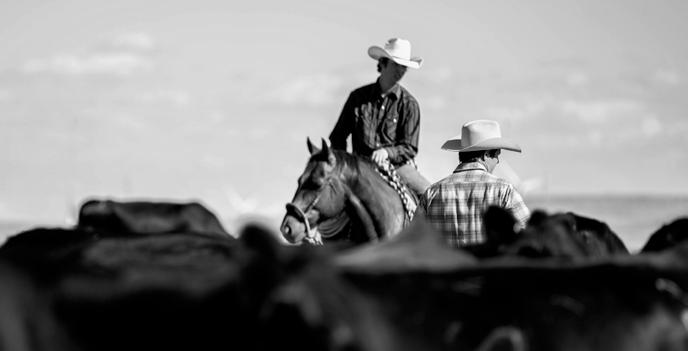
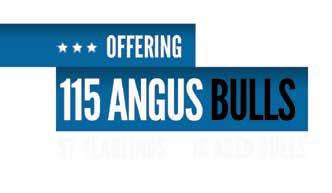


5. CPW also recommends carrying a big stick, although I don’t know what a person is supposed to do with it. Maybe they could try hiding behind it?
6. Pets can also play a role in avoiding a wolf attack. CPW says pets should never be left alone.
I agree, and I think you should hold them tightly. This way when the wolf attacks, you can sacrifice your pet by throwing it at the wolf, and while they’re chowing down on your pooch, you should be doing the running backwards thing we mentioned earlier.
7. CPW advises you should keep something between you and the wolf. I’d suggest it be a nine-millimeter bullet.
If you’re a wolf lover, you might also try showing
In dealing with fellow convicts, I’d advise using the same tactics one would use when dealing with a wolf – never turn your back on them and look big.
REAL BIG.
9. Finally, CPW says if you are attacked – something that could never happen, wink, wink – you should blow on an emergency whistle that you should carry with you at all times if you live in Colorado.
This won’t help you any, but it will help CPW officials in confirming a wolf may have attacked a human.
Later, it will help biologists when they are attaching radio collars to wolves if one of the wolves whistles Yankee Doodle Dandy when it breathes in and out. This wolf was the one that probably killed you, and therefore should be relocated to another state.
UW seminar set
On March 18, the University of Wyoming (UW) College of Agriculture, Life Sciences and Natural Resources will facilitate a seminar on energy innovations hosted by Gillette College.
The seminar is the second in UW’s 2024 Ranching in the West seminar series, which partners with community colleges across the state to provide relevant, meaningful information about ranching and land management to students and agricultural professionals.
The event begins at 5 p.m. in Gillette College’s Technical Education Center. It will also be available via Zoom. For community members and students not seeking academic credit, the cost is $25 per session. Dinner is provided. To register, visit uwyo.edu/uwag/rmal
Following the event in Gillette, UW will host two additional seminars this spring, available in person and via Zoom. Topics, dates, locations and more information are available at uwyo.edu/uwag/rmal
Uinta County to host event
Uinta County is hosting a free event celebrating women in agriculture from 6-8 p.m. on March 8. The event, called “Women in Ag Night,” is a collaboration between University of Wyoming Extension and Utah State University Extension.
“This program is designed to start conversations about women’s involvement within the agricultural industry, brainstorm ideas and give this group of women a community and a group of like-minded individuals,” says McKenna Julian, Uinta County agriculture and natural resources educator.
The night will feature three speakers talking about their experience in the agriculture industry. The first two speakers are FFA Advisor Malinda Broadbent and Utah State University Extension Educator Katelyn Barsnick. The third speaker, Marie McClaren, will share a talk titled “A Sheepherder’s Story.”
Julian adds, “We hope the presenters and allowing this group to get together will help build relationships amongst women and inspire individuals to be very active in all aspects of ag.”
The event will be held at the Beeman-Cashin Building in Evanston. Dinner is provided. Families and people of all genders are welcome to attend.
RSVPs for Women in Ag Night are requested by March 5. To RSVP, contact Uinta County Extension at 307-783-0570.
For questions about Women in Ag Night, contact Julian at mbrinton@uwyo.edu or 307-783-0570.
Wyoming Livestock Roundup • Volume 35 No. 45 • March 2, 2024 B16 S WRANGLER 830 LISCO GRAND FINALE 4103 DEER VALLEY GROWTH FUND S RIGHT TIME 7861 U2 COALITION 206C ELLINGSON UPLOAD 1004 ALL BULLS PAP TESTED FOR USE ON HIGH-ALTITUDE RANCHES AI SIRES: FRI 22 MARCH 2024 - 1PM LISCO & M DIAMOND ANGUS BULL SALE LOCATION: M DIAMOND RANCH — 65 BULLS SUITABLE FOR USE ON FIRST CALF HEIFERS — LISCOANGUS.COM | MDIAMONDANGUS.COM BRAD @ M DIAMOND ANGUS: (307) 359-1162 | DICK @ LISCO ANGUS: (307) 359- 0167
IT'S THE PITTS Look BIG!































































































































































































































